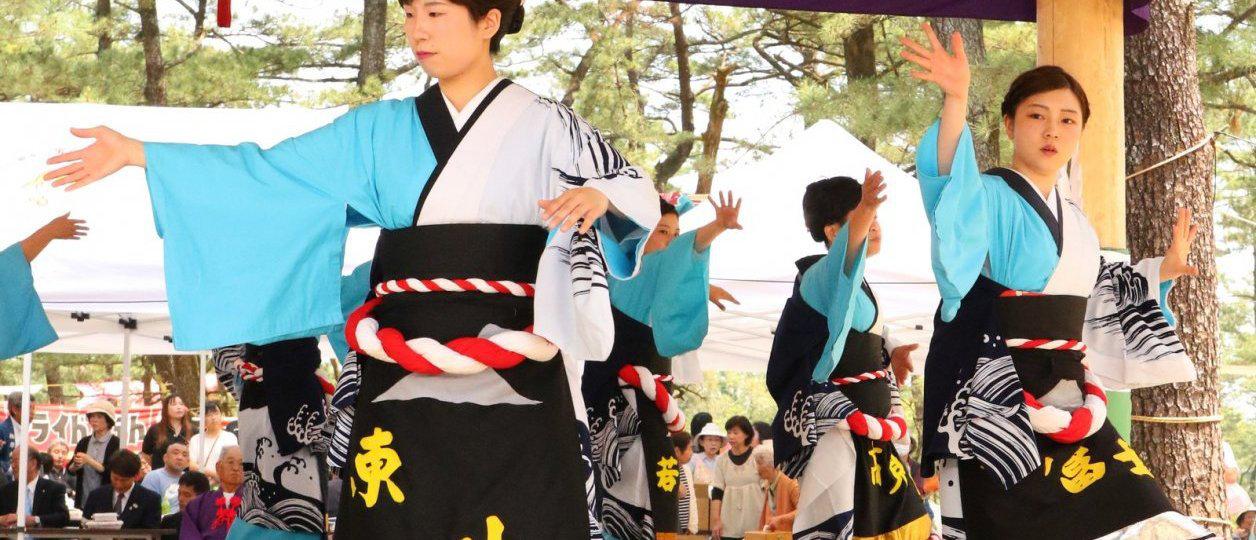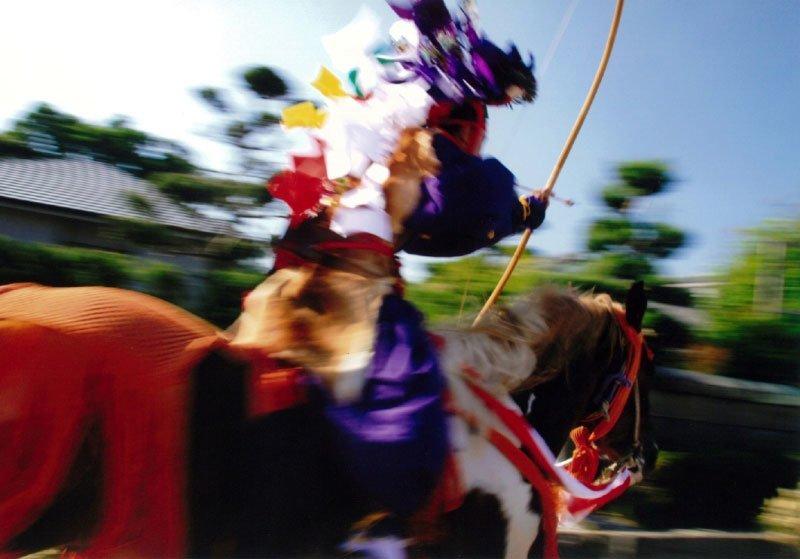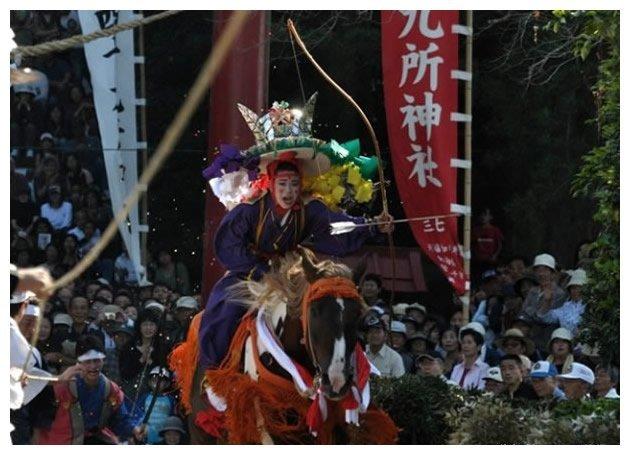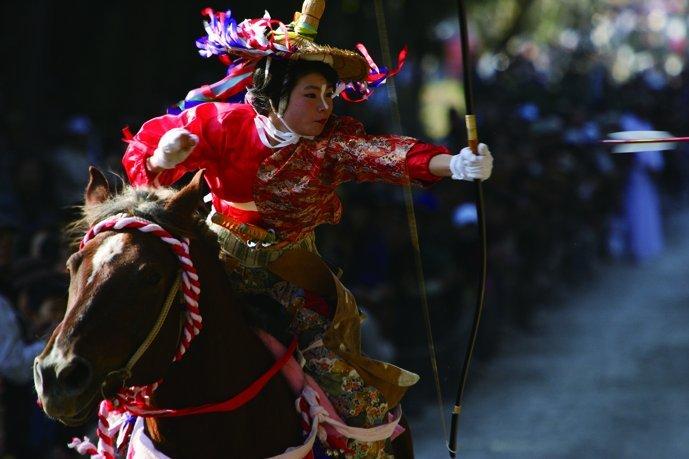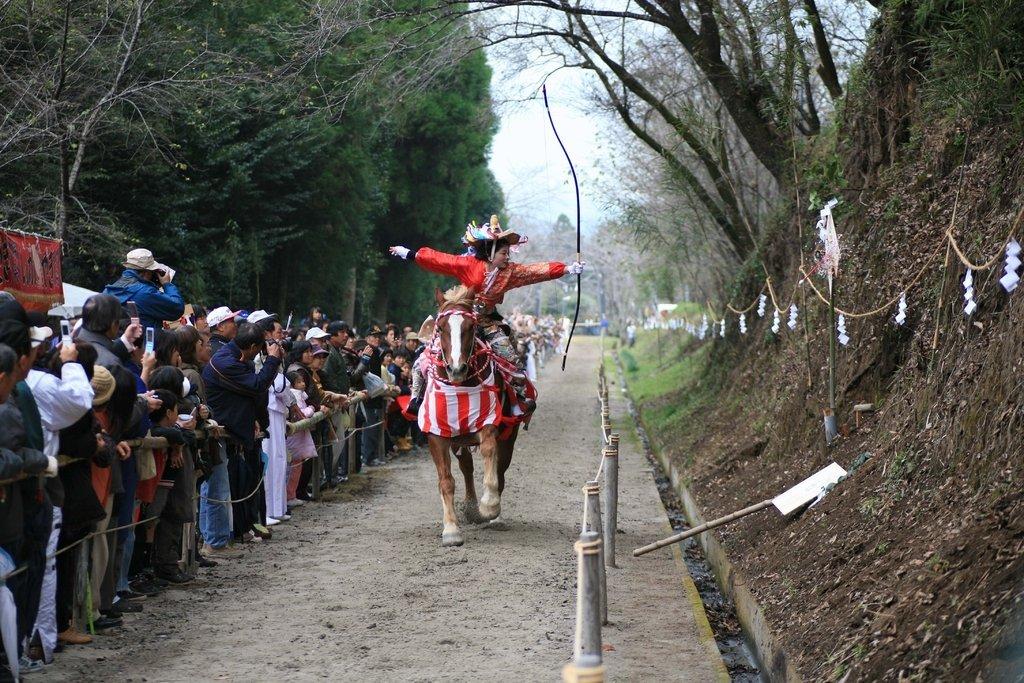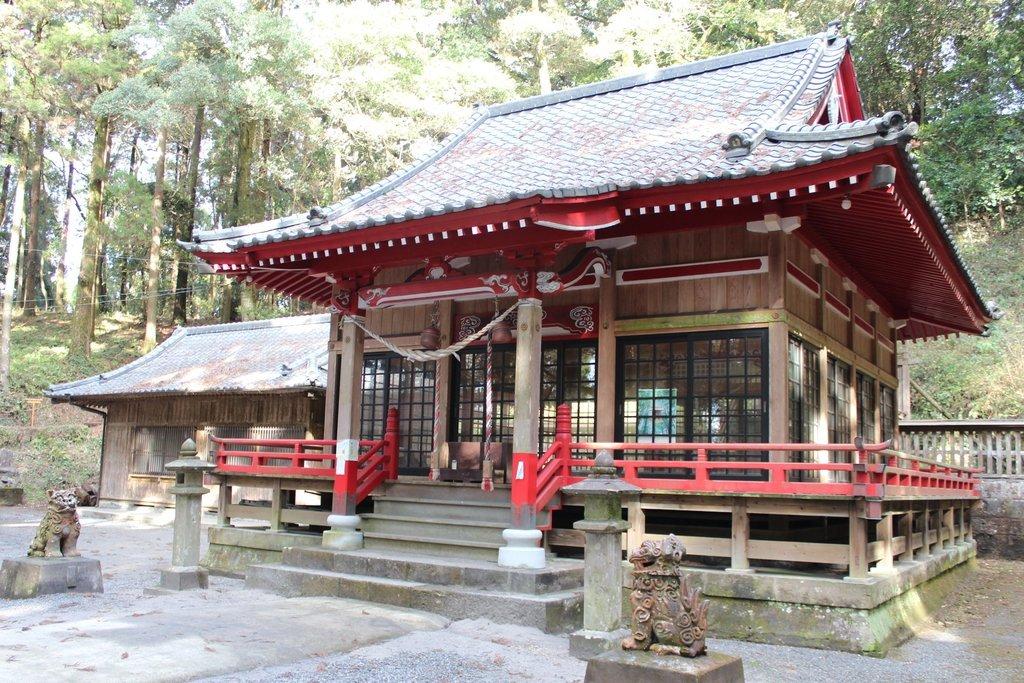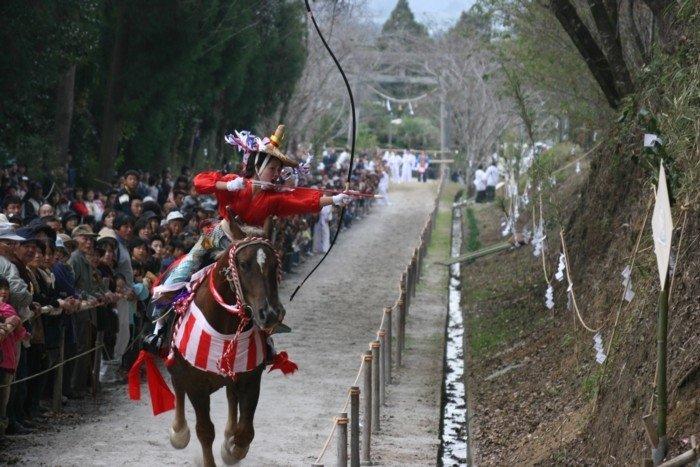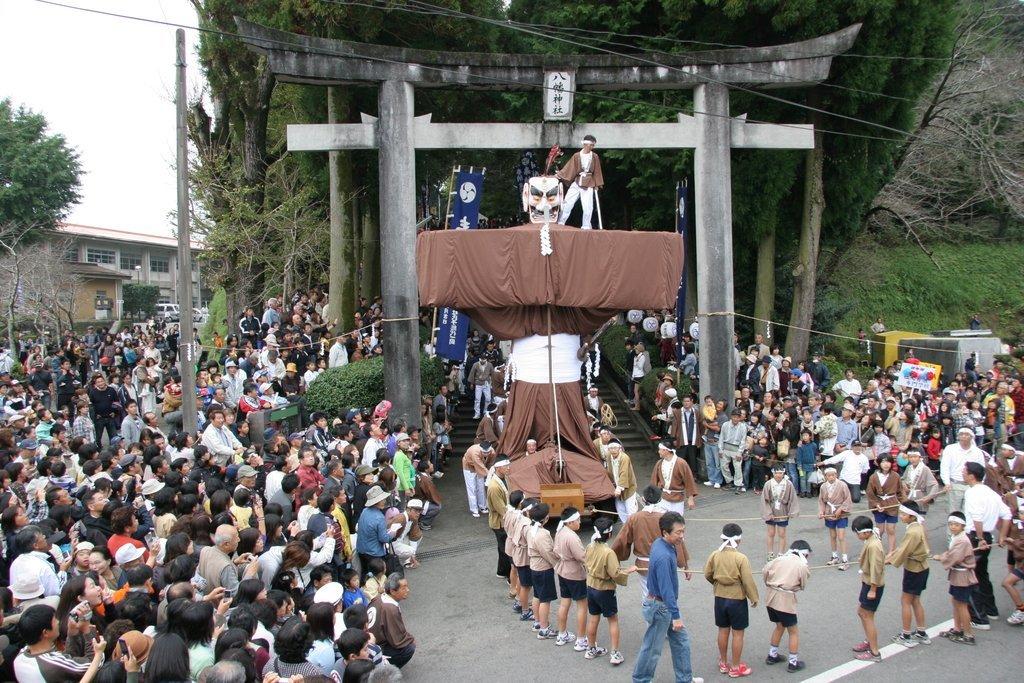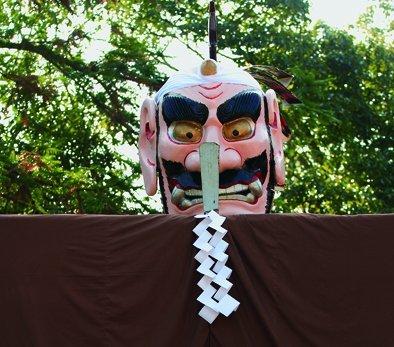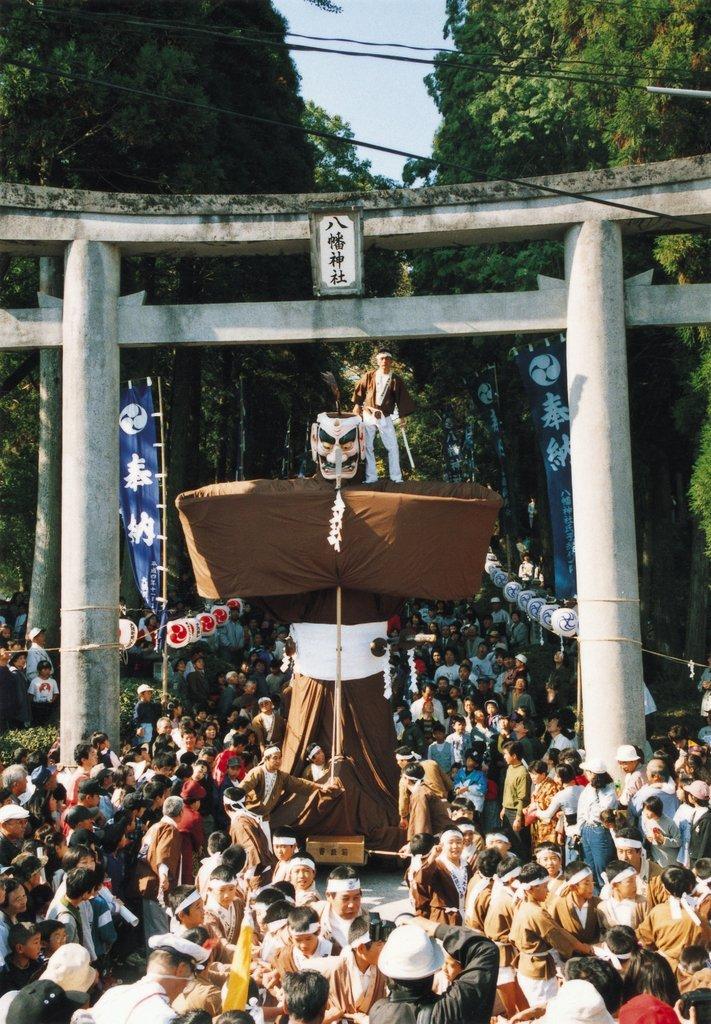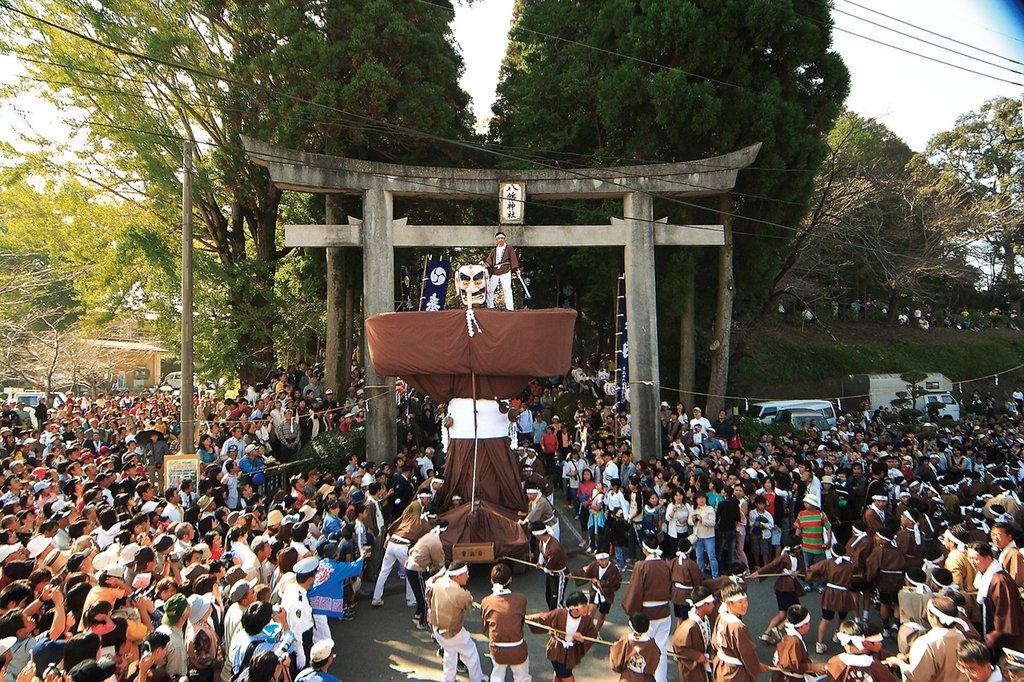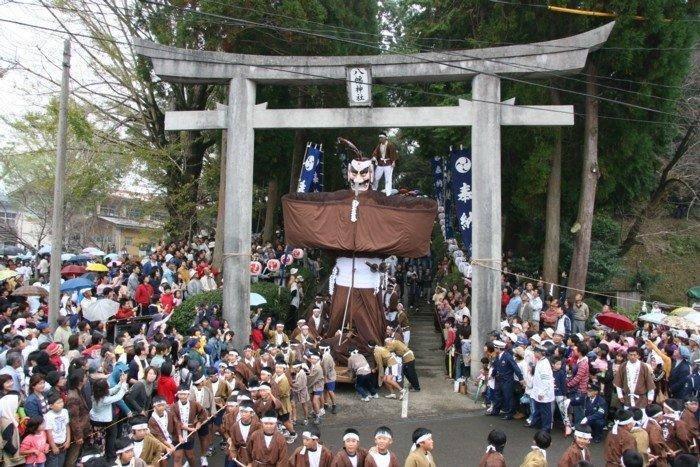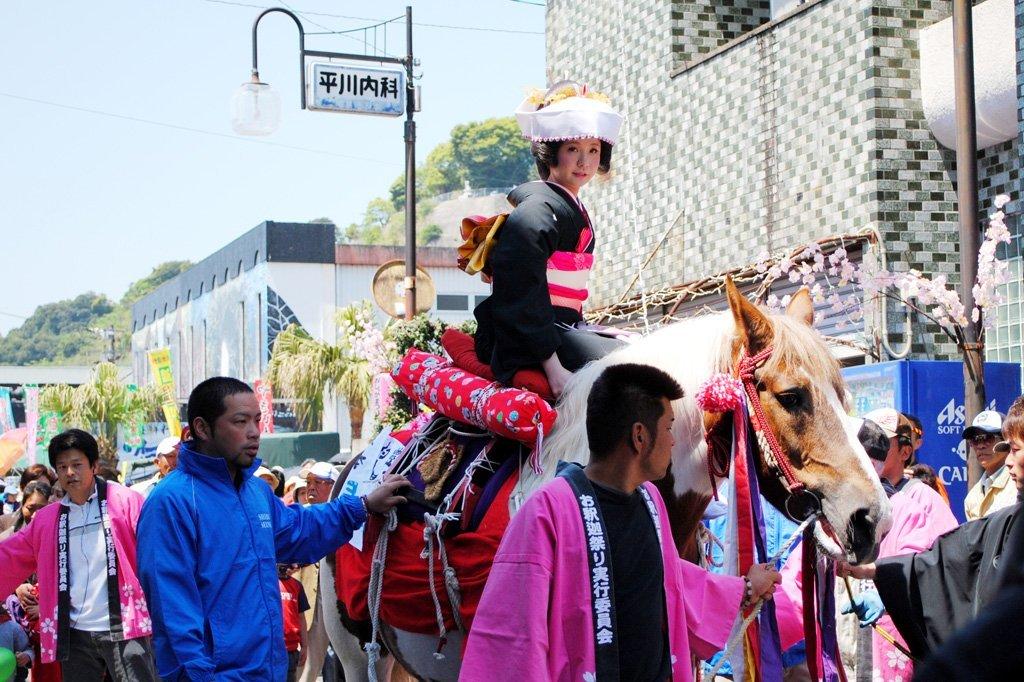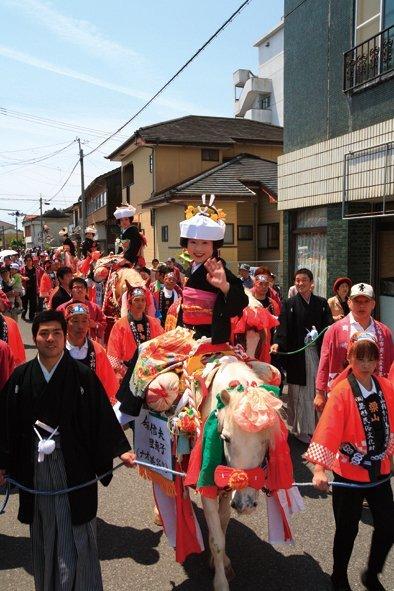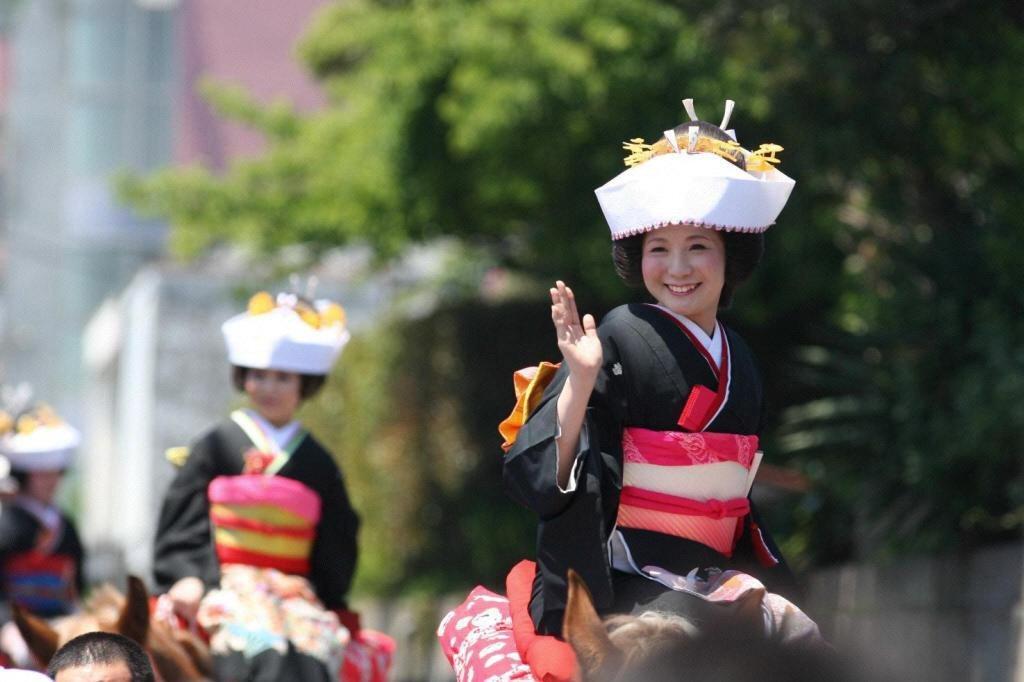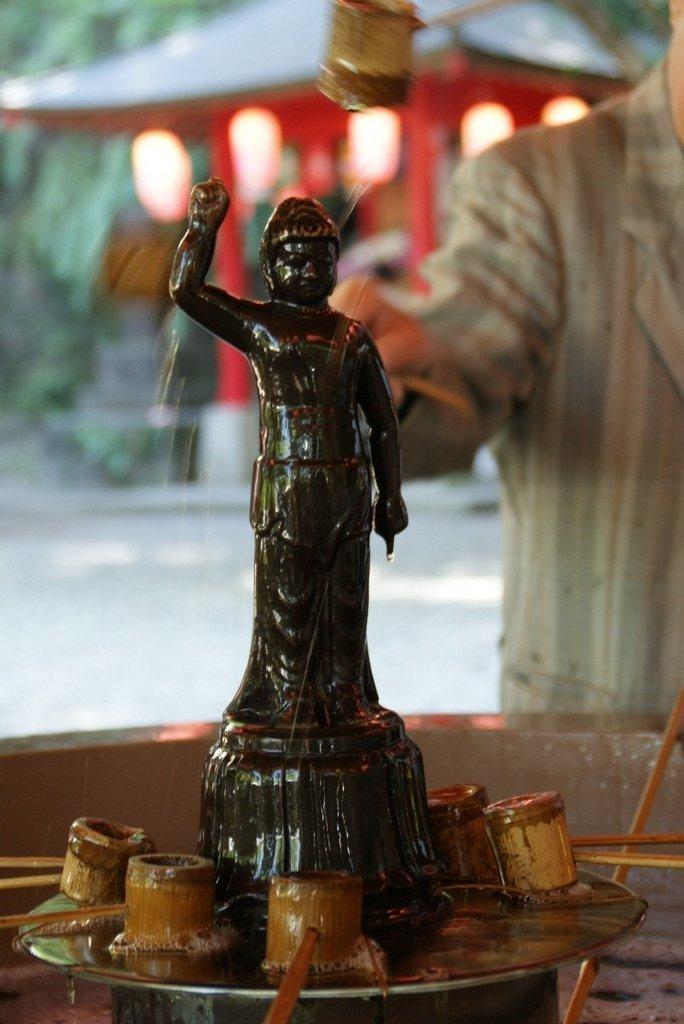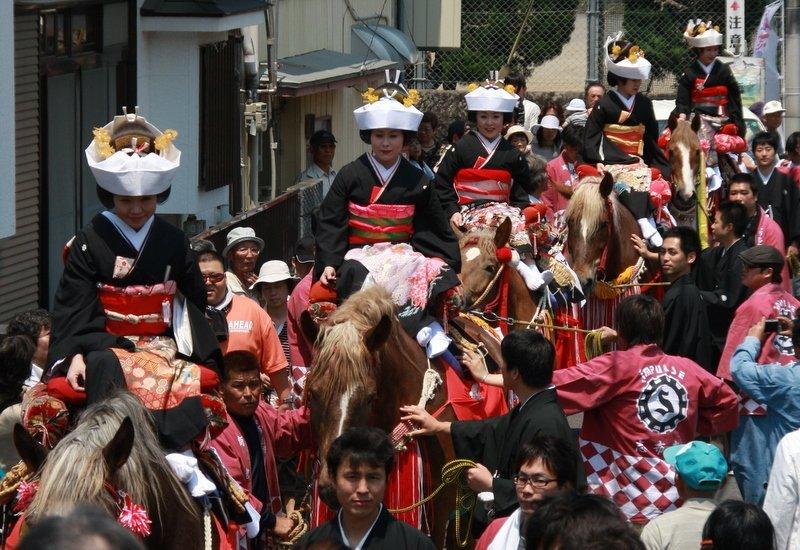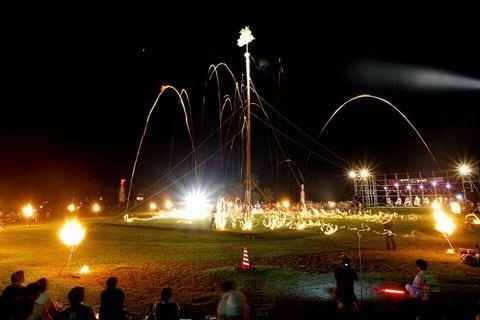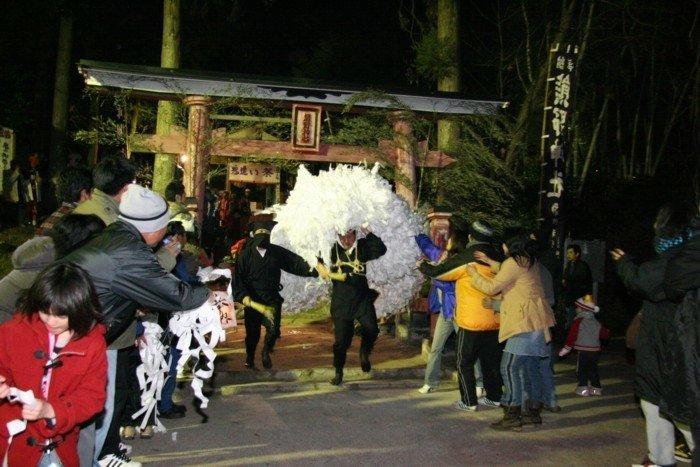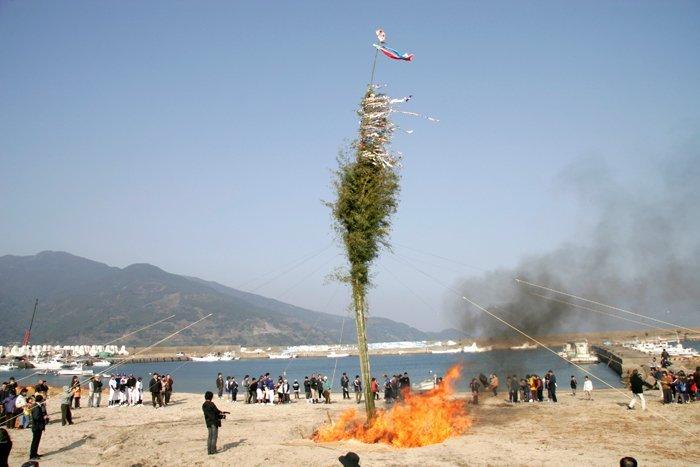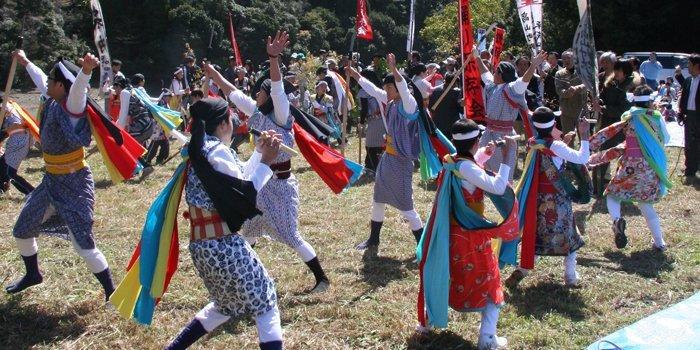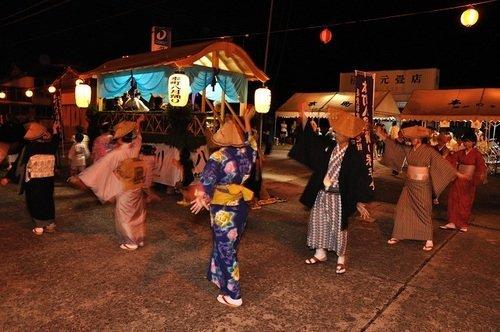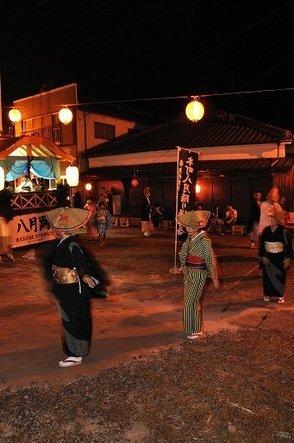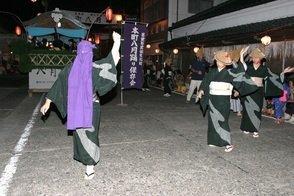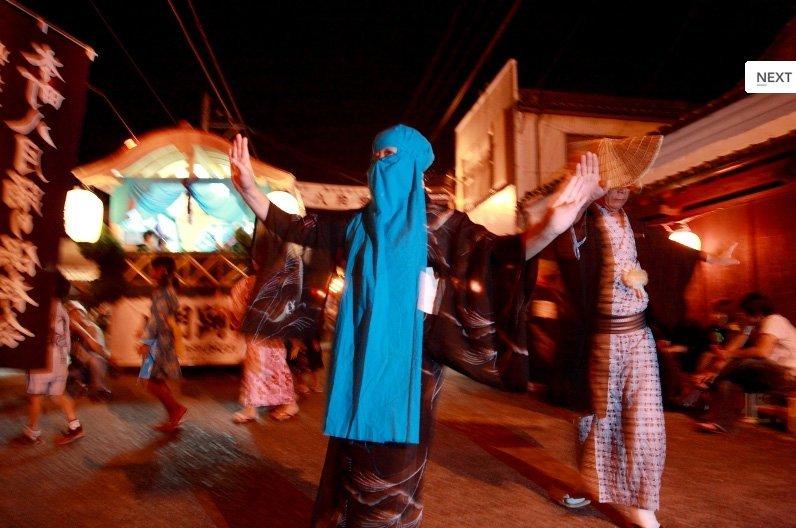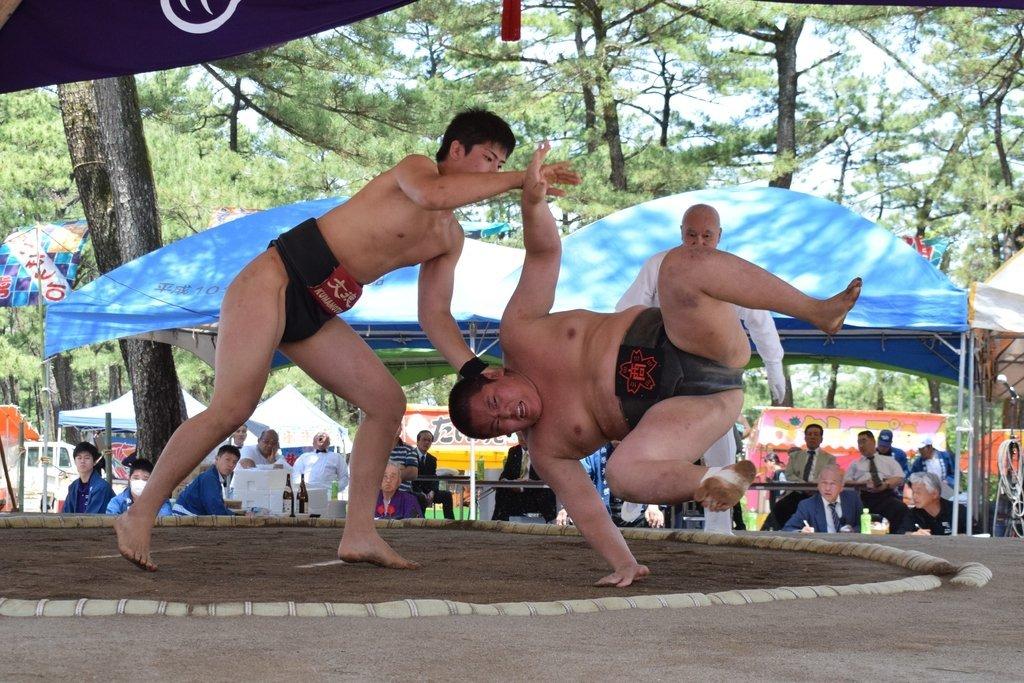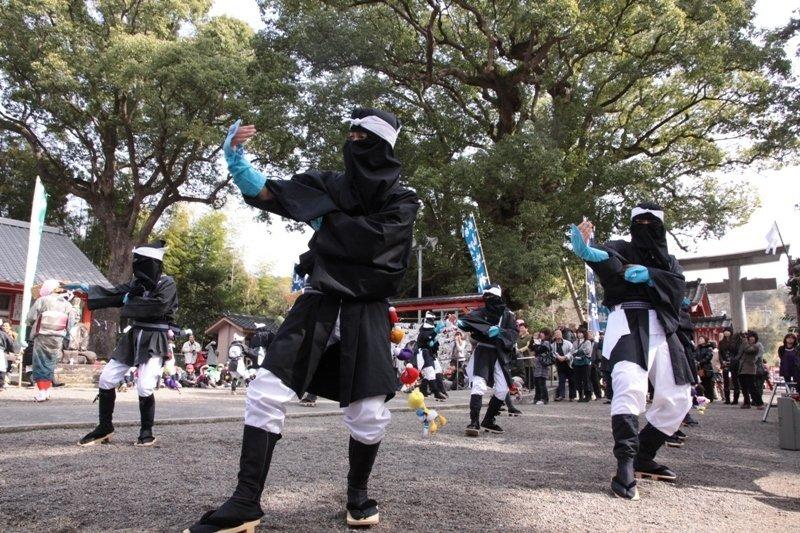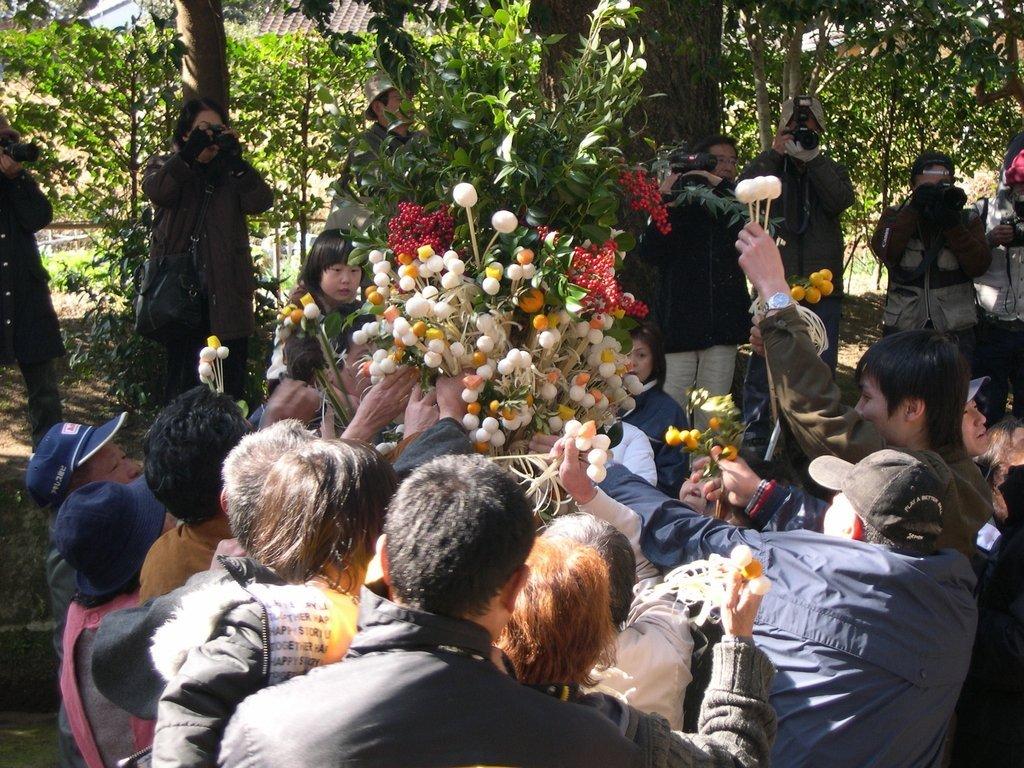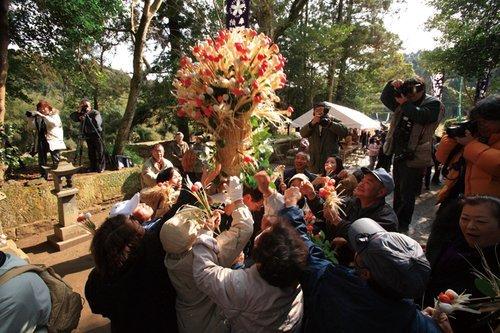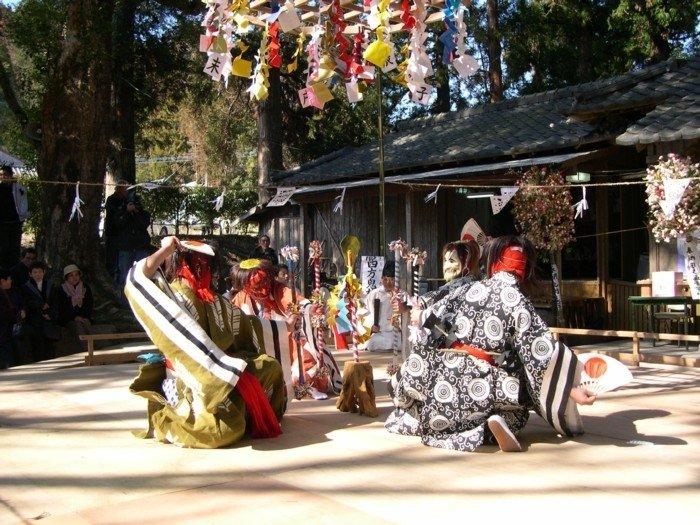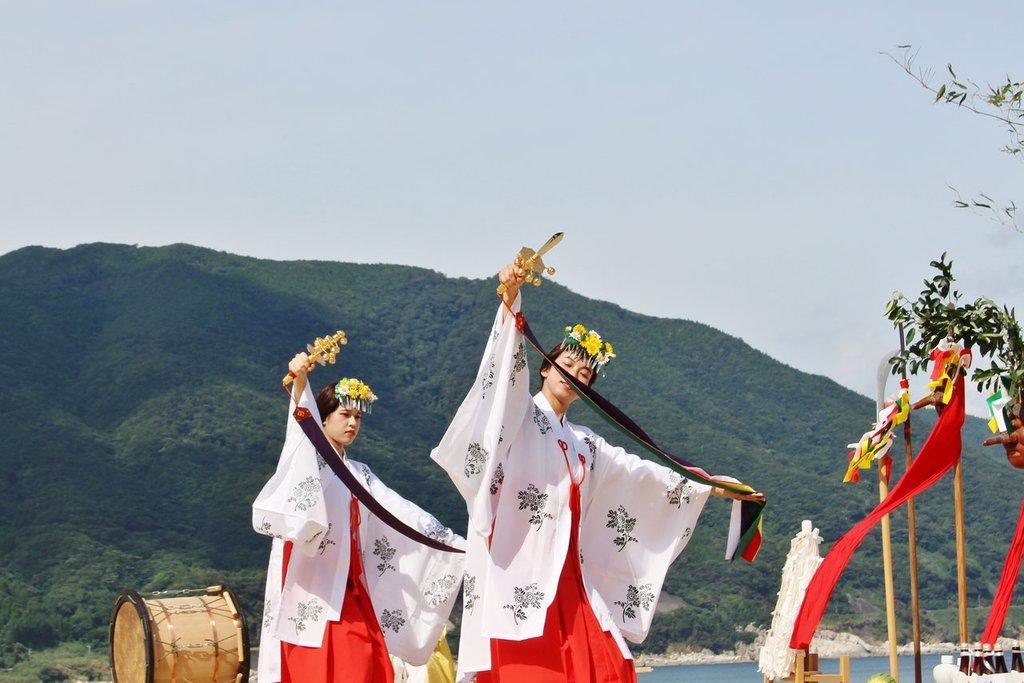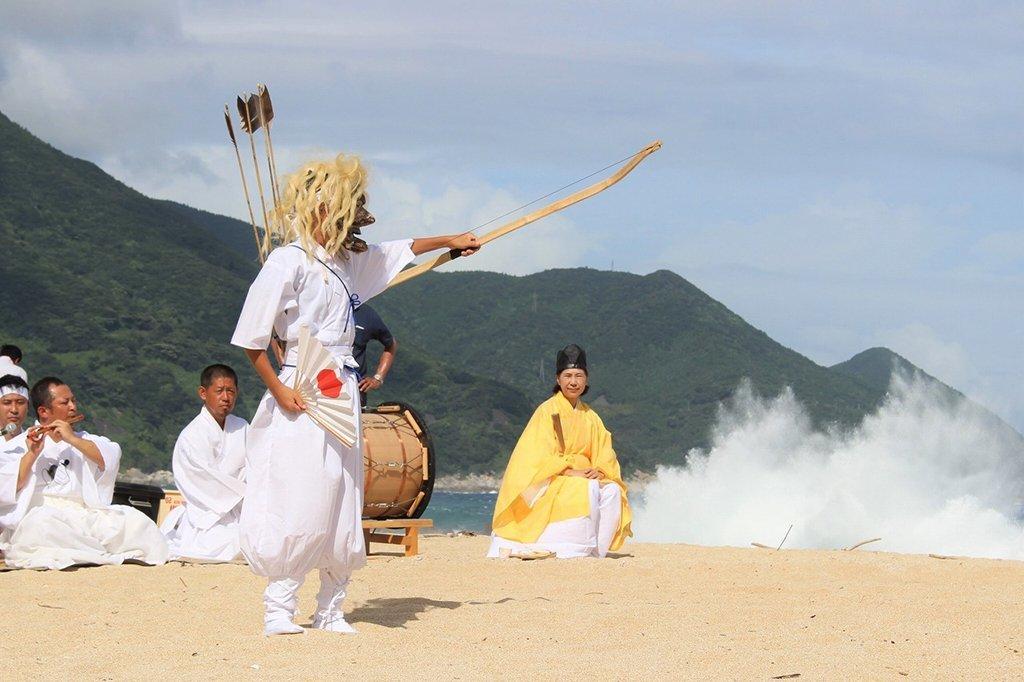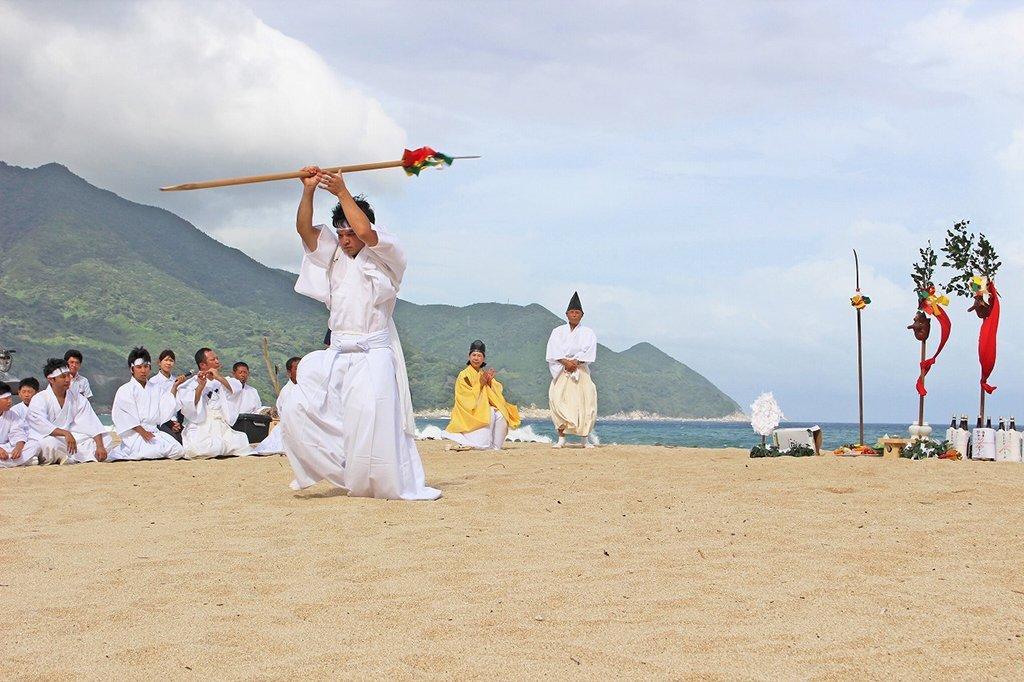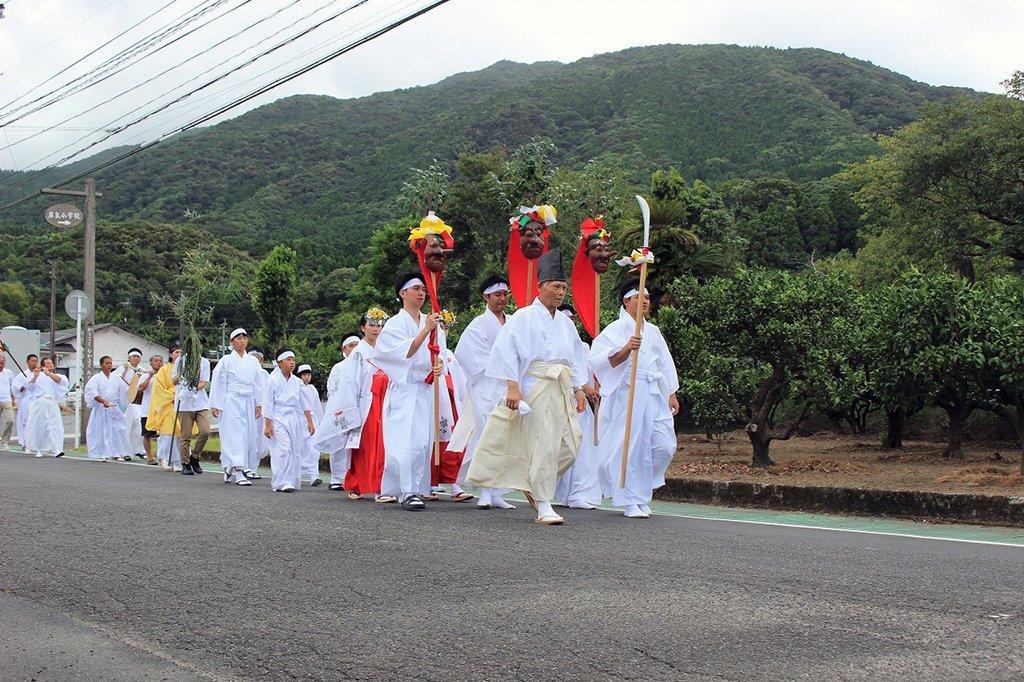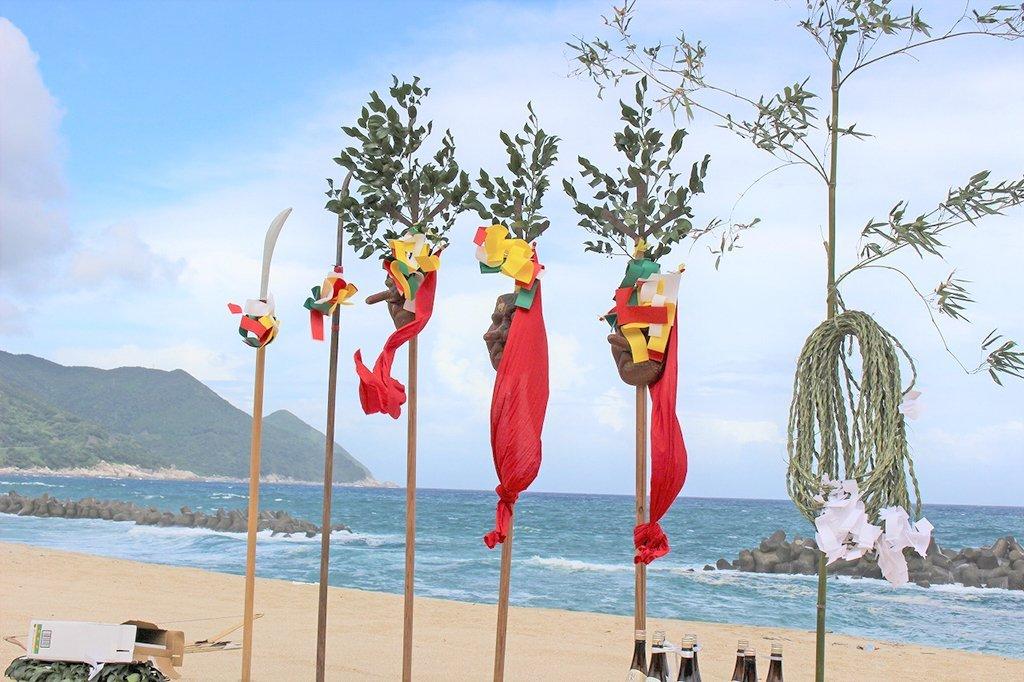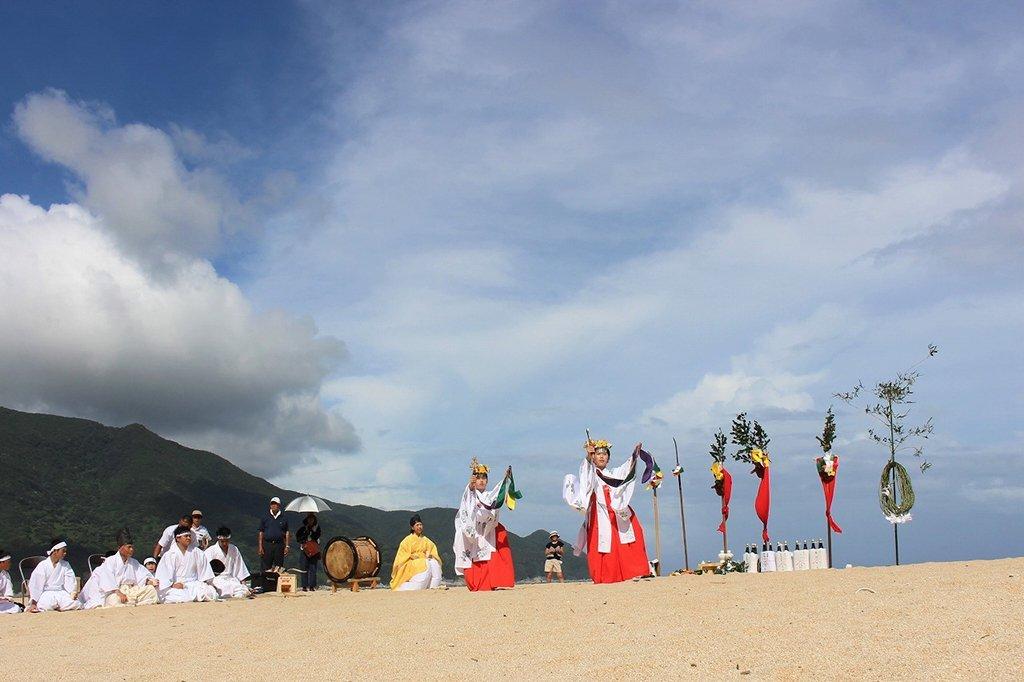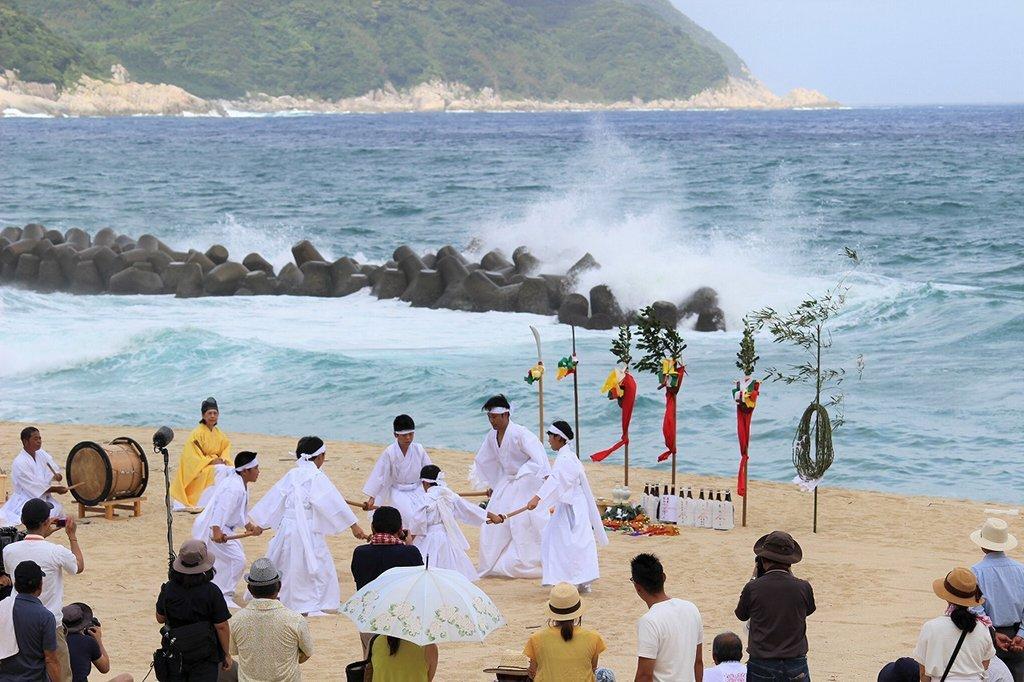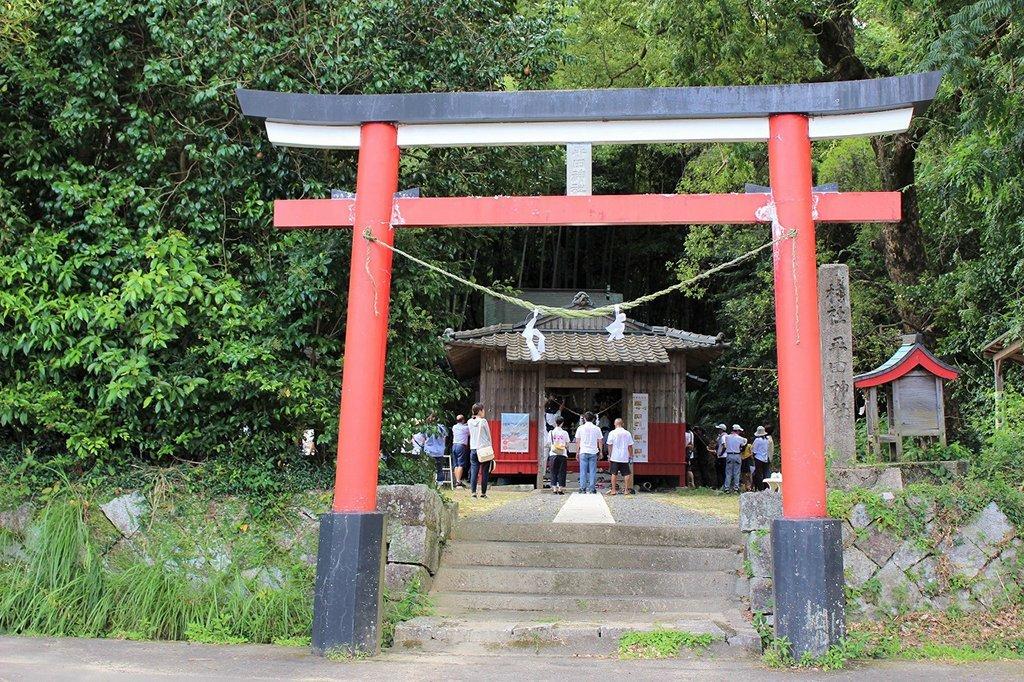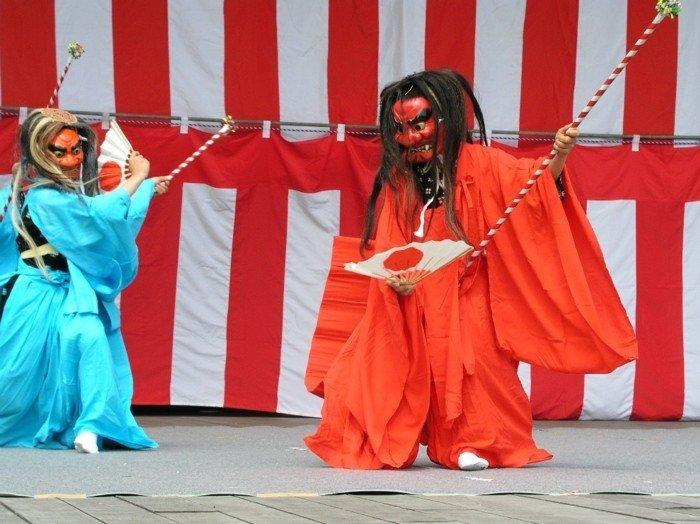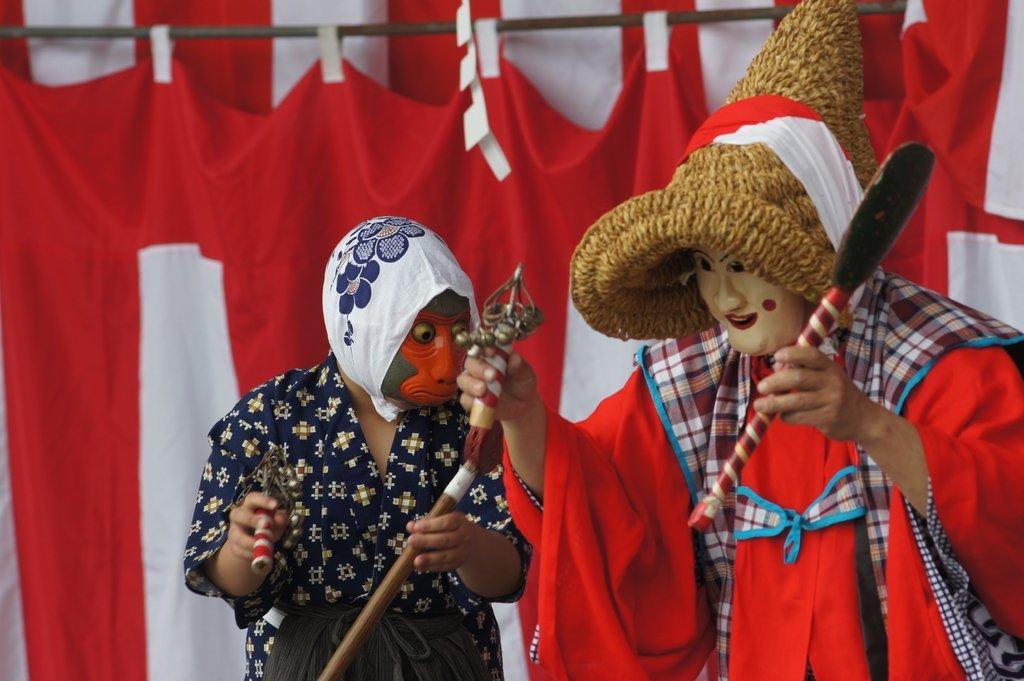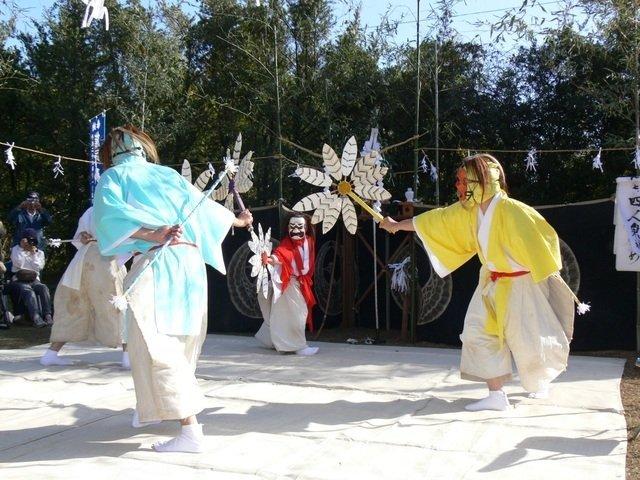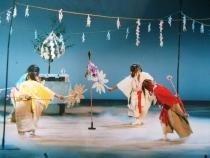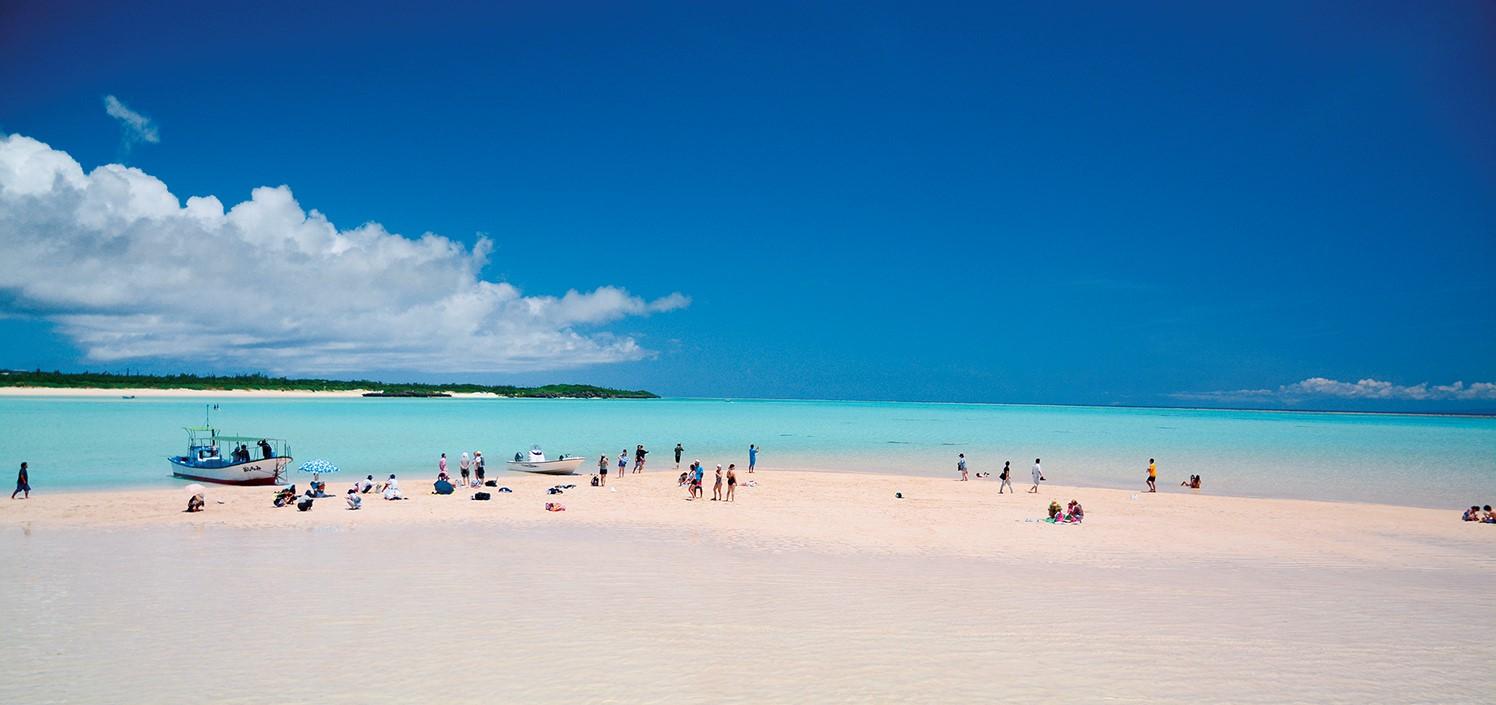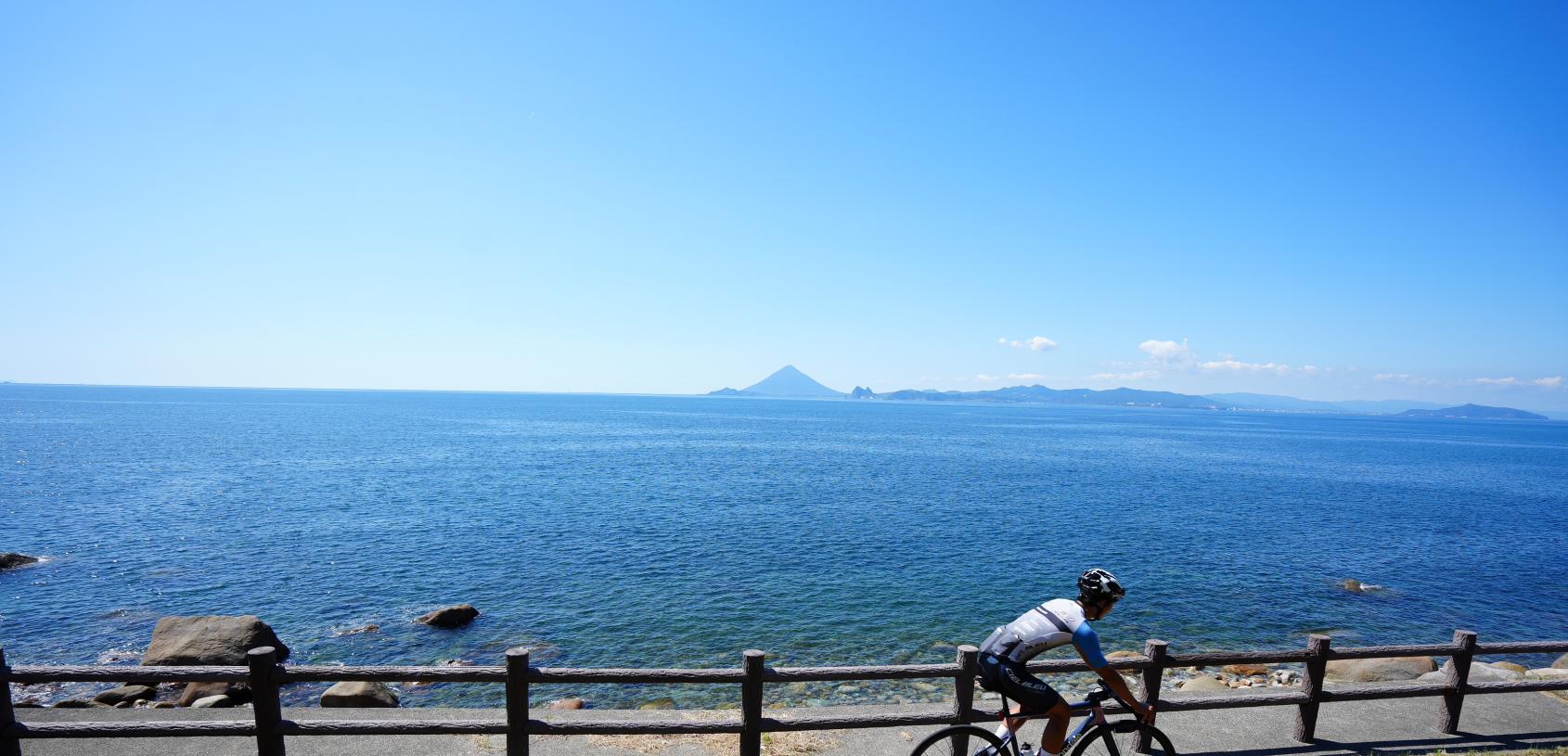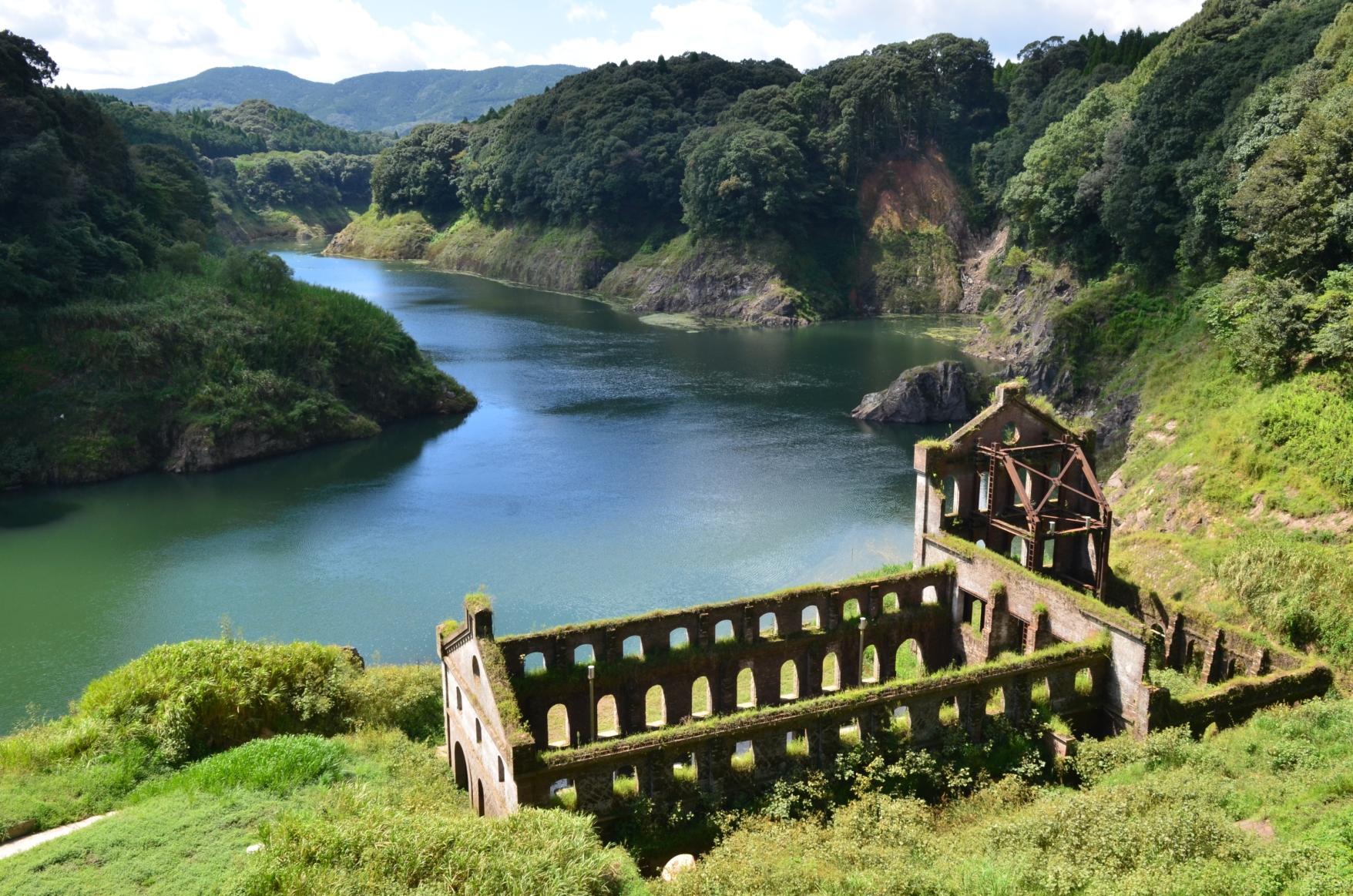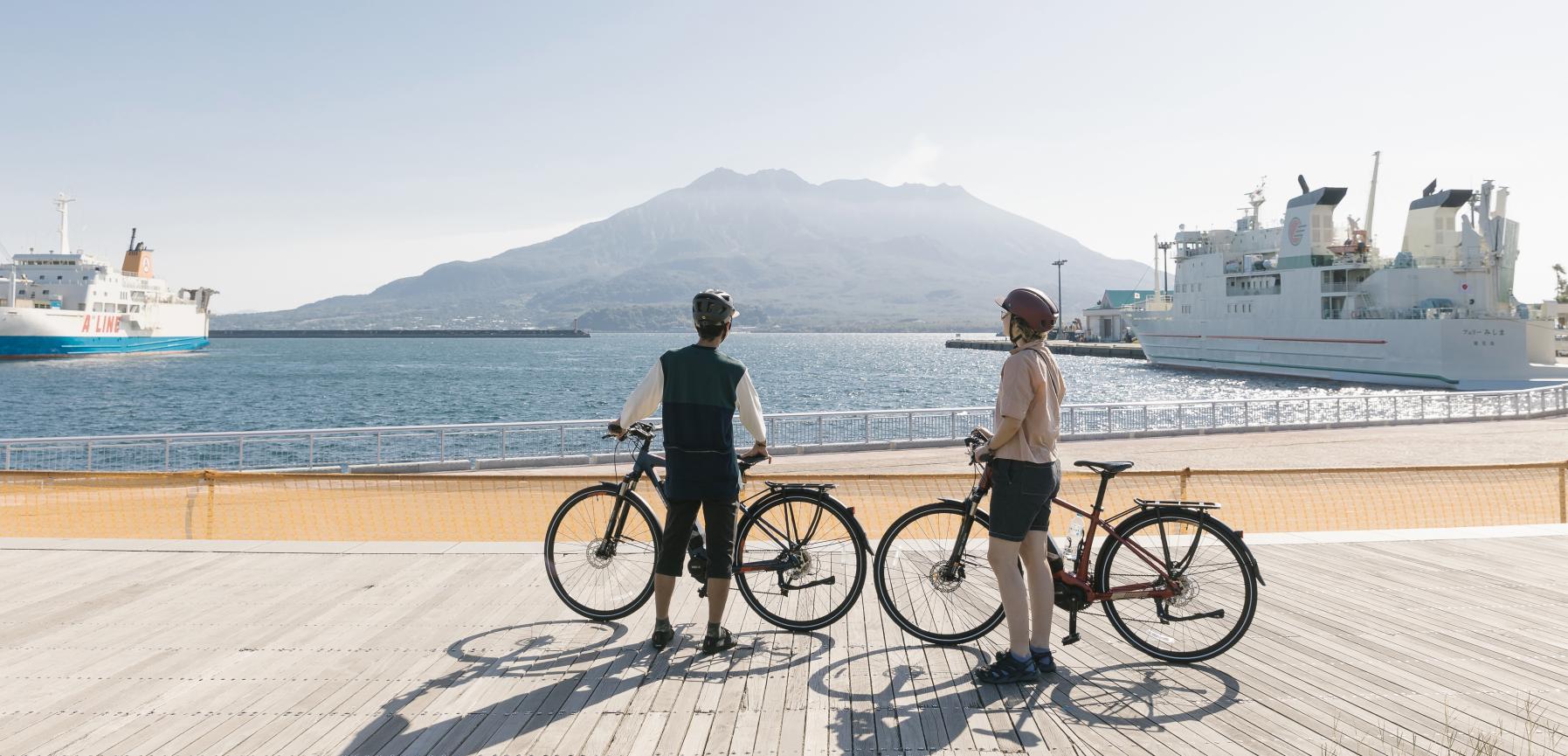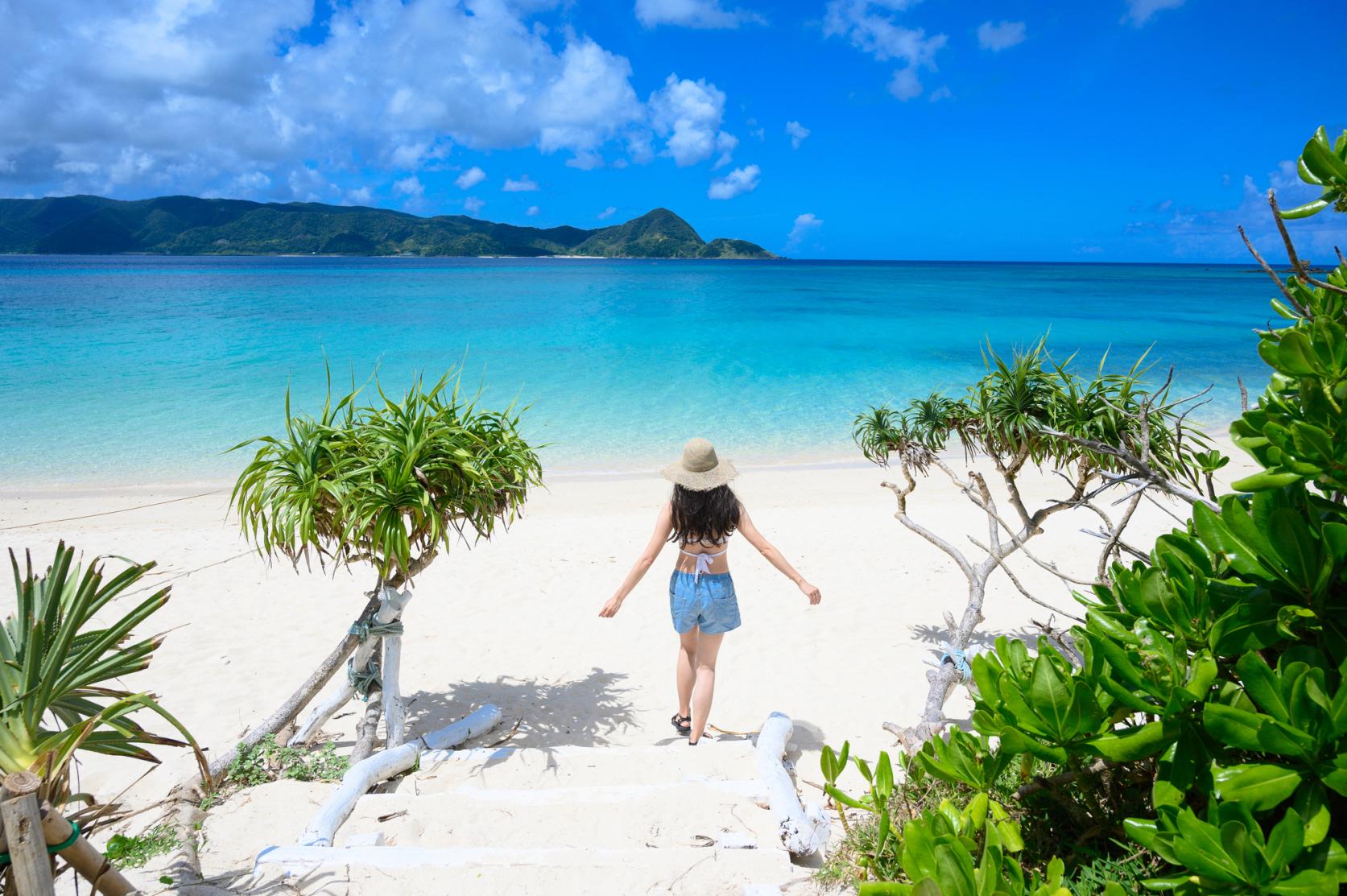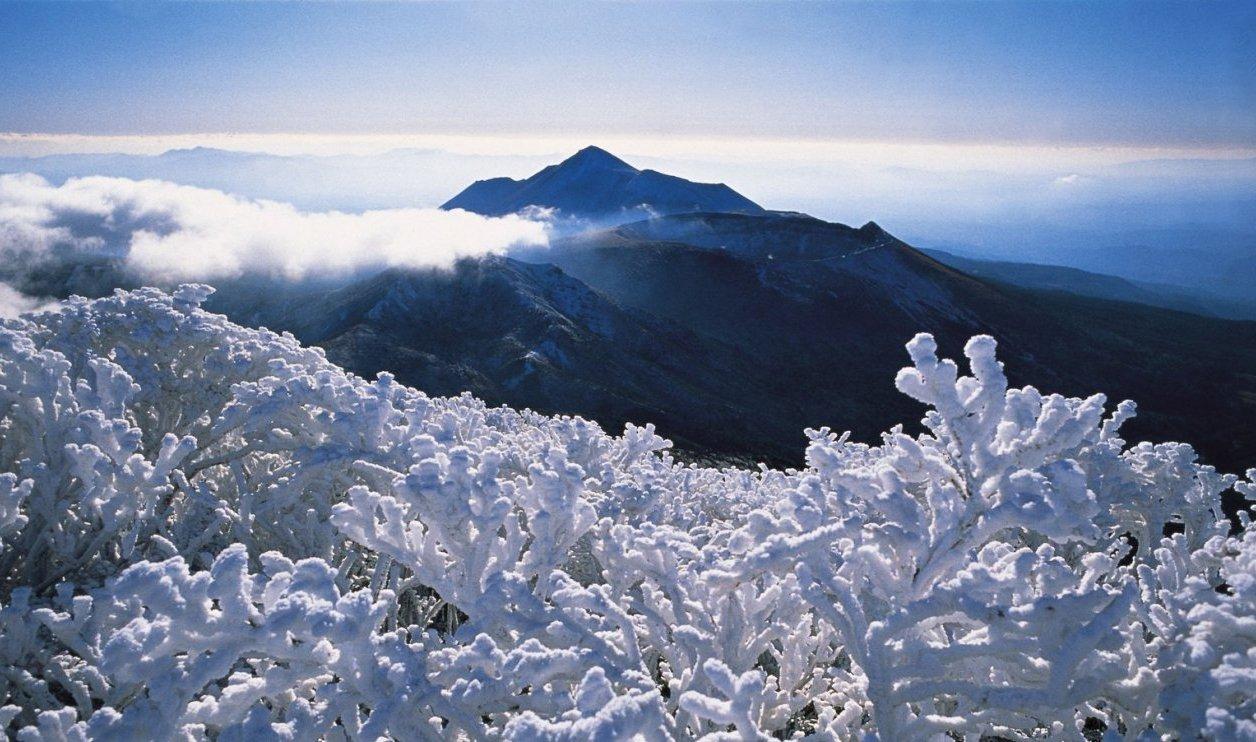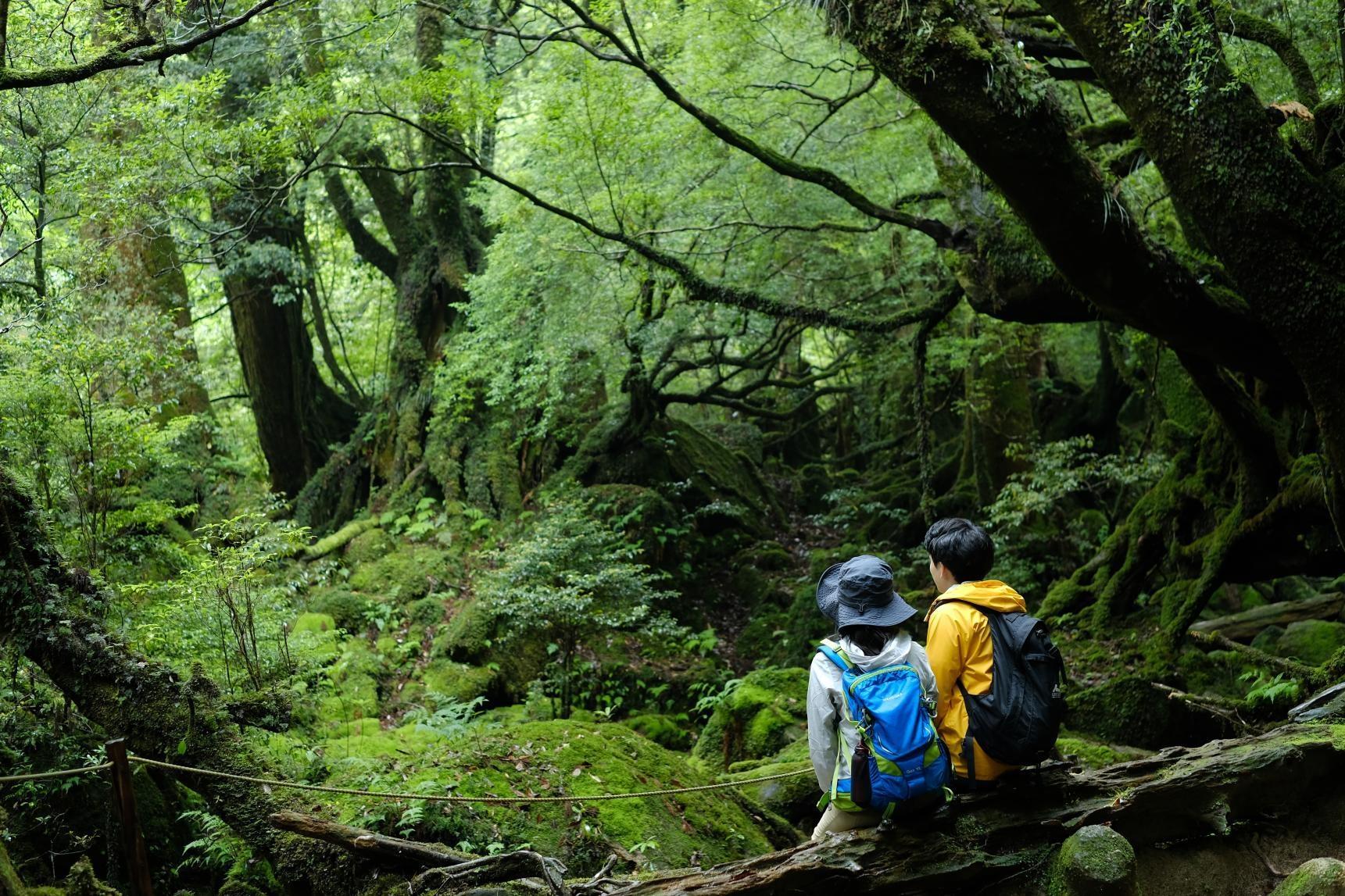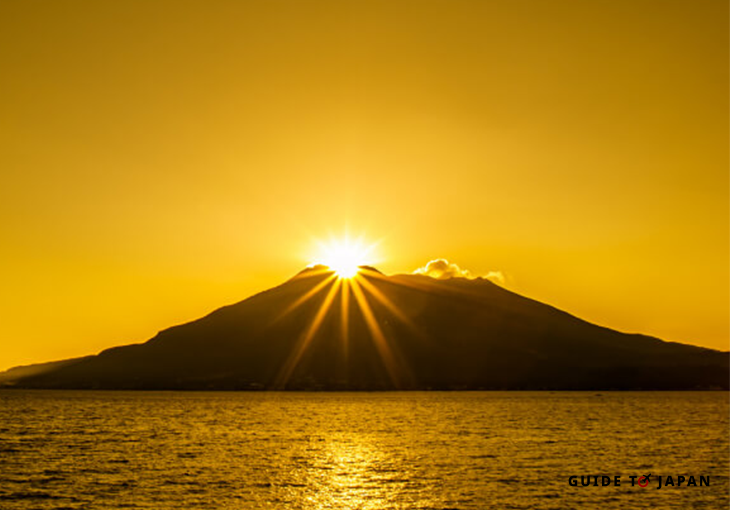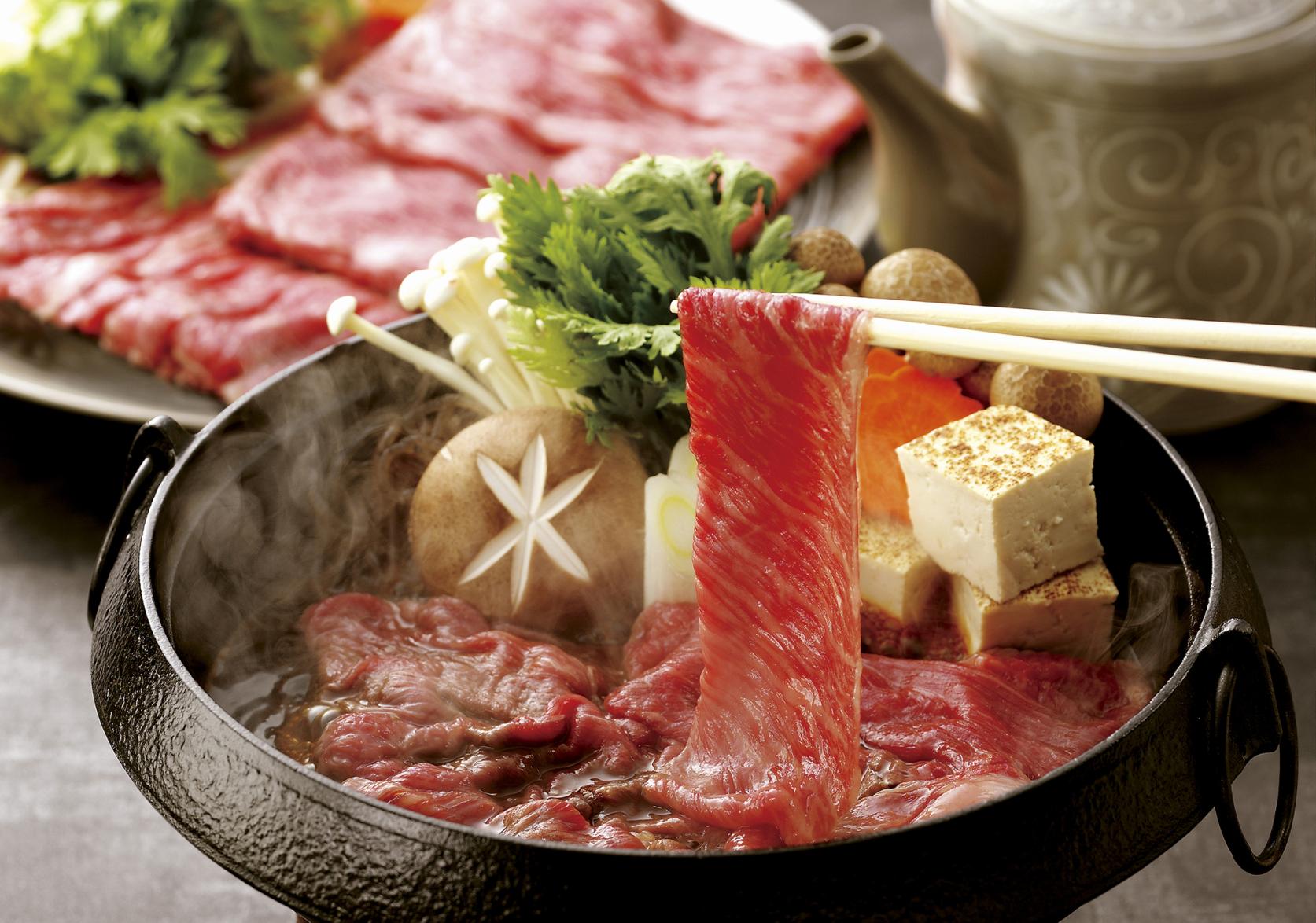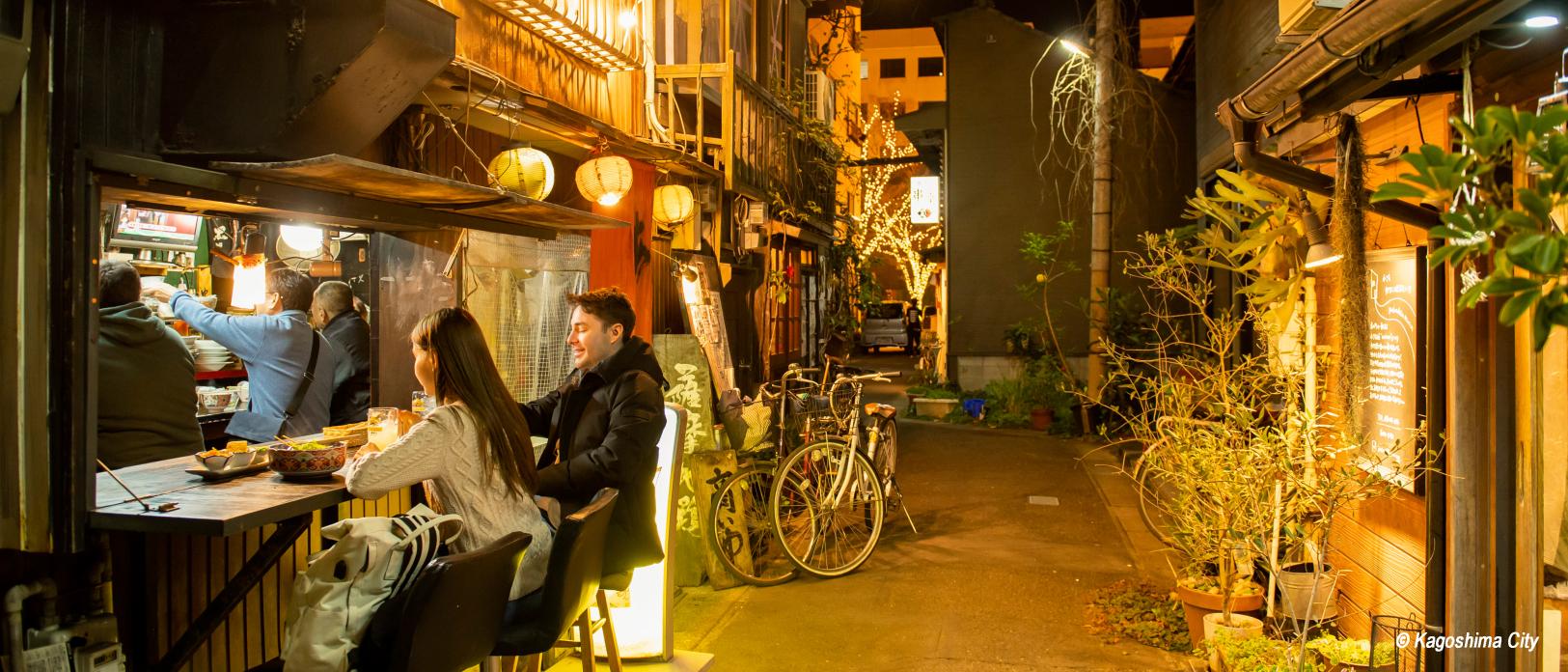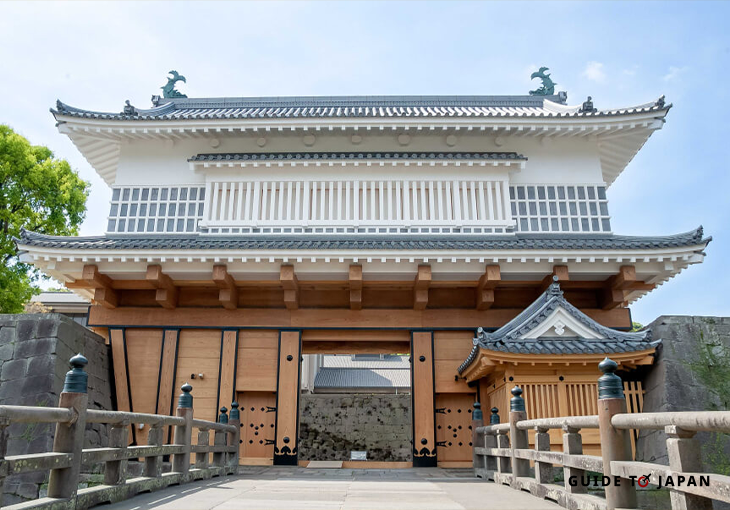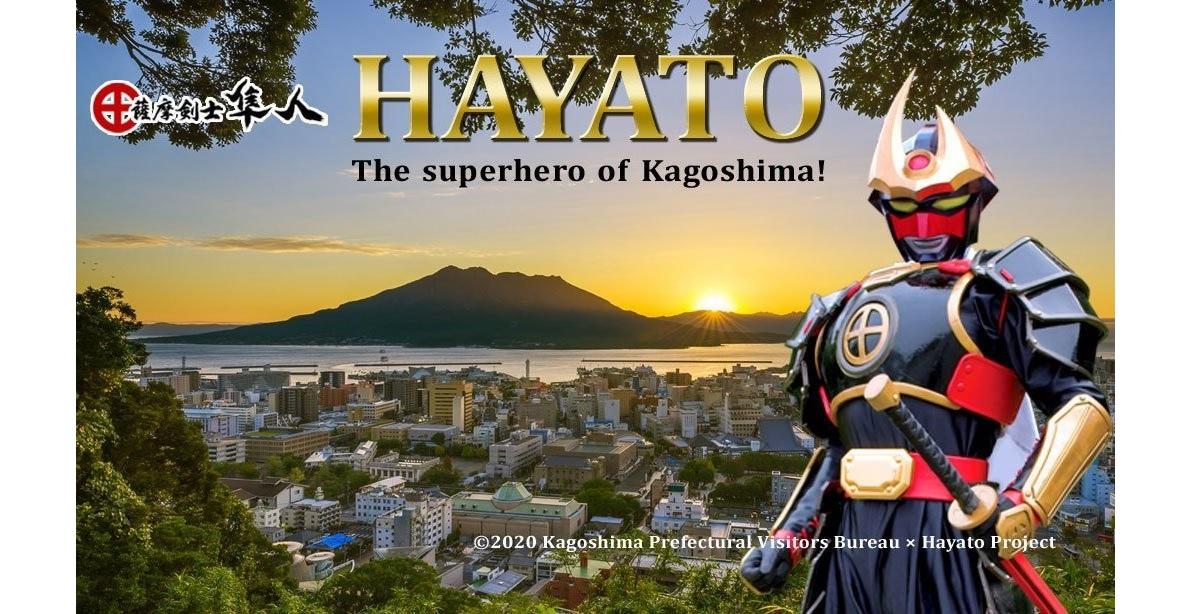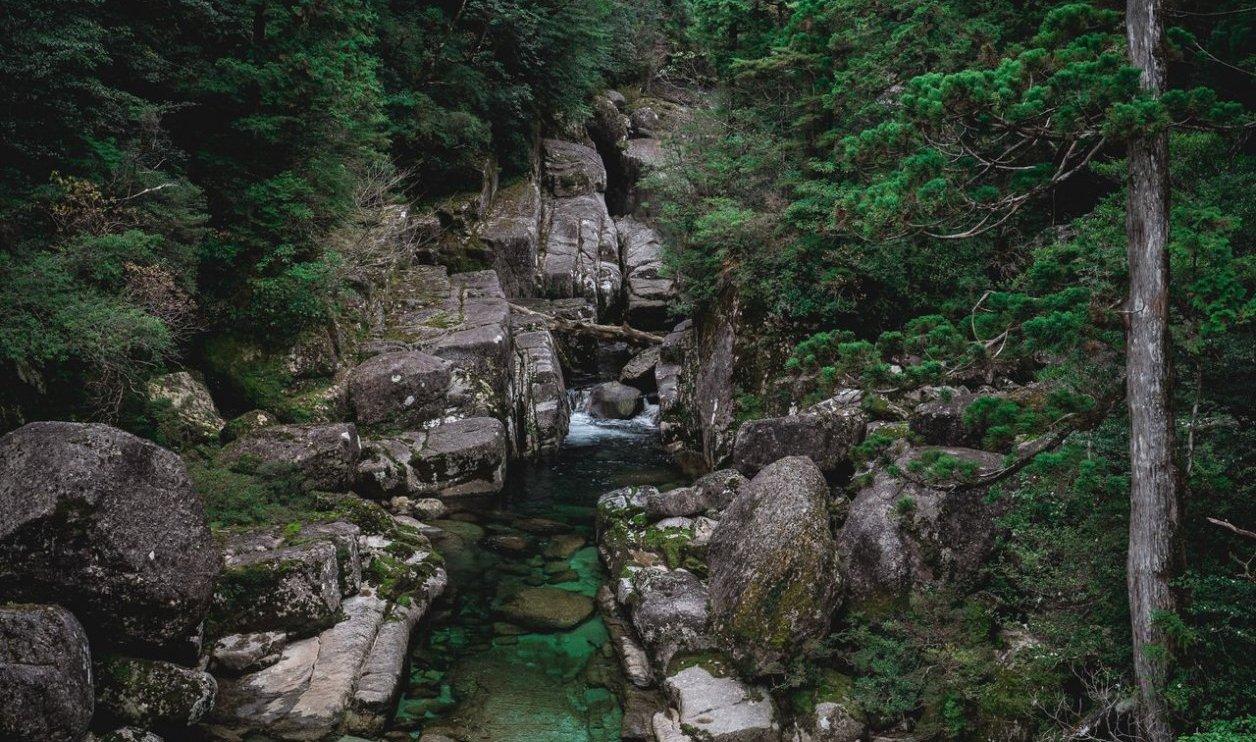Shijukusho Shrine Yabusame (Horseback Archery)
3rd Sunday in October
Intangible Folk Cultural Property
Yabusame is a festival that exemplifies and upholds the traditions of the Osumi Peninsula. It refers to the technique, exercise, and ritual of traditional Japanese equestrian archery, of shooting a kaburaya (whistling arrow) from atop a galloping horse. Nowadays, yabusame is performed in two locations in the Osumi Peninsula: at Shijukusho Shrine in Kimotsuki and Sumiyoshi Shrine in Sueyoshi.
In the Yumiuke no Gi (Accepting of the Bow Ritual), the archer is appointed as a divine messenger. Donning a kariginu (hunting garment) and ayaigasa (conical hat), he races down the track on his sacred horse.
The horse rushes out to the call of the hikite (the horse’s handler) and carries the archer through the roughly 330-meter (360-yard) track three times, during which time the archer fires a total of nine arrows.
Sueyoshi Sumiyoshi Shrine Yabusame (Horseback Archery)
November 23 (Labor Thanksgiving Day)
Intangible Folk Cultural Property
Sueyoshi Shrine is host to one of the three yabusame (horseback archery) festivals in Kagoshima Prefecture (along with Shijukusho Shrine in Koyama, Kimotsuki and Oonamuchi Shrine in Fukiage, Hioki). As recorded in Sangoku Meishozue (Geography of Southern Kyushu), the Sueyoshi Shrine yabusame was already a fixture in the mid-19th century; however, no one knows how far it dates back. The festival is held at the time of the fall harvest celebration. Specifically, it used to be held on November 19th, but it is now held on November 23rd (Labor Thanksgiving Day, a national holiday).
The event is held to pray for national prosperity and an abundant harvest. It is said that the more arrows that hit the target, the better the next year’s harvest will be. In 1981, the Sumiyoshi Shrine yabusame was designated as a Prefectural Intangible Folk Cultural Property.
Iwagawa Yahata Shrine Yagorodon Festival
November 3
Intangible Folk Cultural Property
Every year, the Yagorodon procession begins at 2:00 AM on November 3. A Shinto ritual is held around the shrine to the beat of an okoshi daiko (rousing drum). At around 3:00 AM, the assembly of the giant Yagorodon doll begins. The body of Yagorodon is made of bamboo baskets and clothed with a massive plum-dyed hitoe (unlined cotton kimono). At about 5:00 AM, amidst the thunder of the Yagorodon okoshi daiko, Yagorodon is stood up on a four-wheel car body. When completed, Yagorodon stands 4.85 meters (16 feet) tall. At 1:00 PM, the hamakudari (procession to the sea) begins; pulled by local children, Yagorodon then parades through the streets.
Another Shinto ritual is held at the Osumi Chuo Community Center, where Yagorodon rests on his journey. In the yard of Iwagawa Elementary School, about 1,000 people participate in a tournament of martial arts such as judo, kendo, kyudo, and sumo as a divine offering. Babanodori Street is lined with stalls, and visitors on the shrine grounds are treated to amazake (sweet, mild sake) and konjac.
Legend has it that Yagorodon was either the incarnation of warrior-statesman Takenouchi no Sukune or the chief of the local Hayato Clan. In 1988, the Yagorodon Festival was designated as a Prefectural Intangible Folk Cultural Property. There are actually three Yagorodon Festivals in southern Kyushu; as written in Sangoku Meishozue (Geography of Southern Kyushu), the festival in Yamanokuchi, Miyazaki Prefecture is the eldest son; the festival in Soo, Kagoshima Prefecture is the second son; and the festival in Nichinan, Miyazaki Prefecture is the third son.
Shibushi Buddha Festival
April 29 (Greenery Day)
The Buddha Festival celebrates the birthday of Siddhartha Gautama, which is believed to be April 8. The festival is held primarily at Homan-ji, a temple which is said to have been established in the 8th century and is dedicated to the worship of Kannon (the Goddess of Mercy). The date April 8, “shigatsu yohka” in standard Japanese, is pronounced in Kagoshima dialect as “shigajjoka”, the local name for the festival. The Buddha Festival is one of the three biggest festivals in Kagoshima.
The Buddha Festival has been celebrated in grand fashion since the Edo Period (1603−1868). Currently, it is held on April 29 (Greenery Day, a national holiday).
Since Homan-ji offers blessings for easy childbirth, the festival features a parade of brides riding on horses decorated with bells. The lively proceedings also include a procession of small children carried in swing-like baskets and a parade of warriors marching through town.
Cape Toi, Kushima: Cape Toi Fire Festival
4th Friday and Saturday in August
This festival, held on the 4th Friday and Saturday of August on Cape Toi, is the largest festival in Kushima. The powerful climax of the festival is a dynamic, mad fire dance that scorches the night sky and takes your breath away.
Originally known as the Full Moon Night Pillar Festival, the Fire Festival reenacts an ancient legend in which a monk named Eitokubo wielded fire to defeat a giant serpent that was terrorizing the people. In the festival, the serpent is depicted as a 30-meter (98-foot) pine tree, which is topped by a pile of straw representing the serpent’s mouth. With a call of “Tontokototte, Eitokubo” (“Eitokubo has killed the serpent at last”), dancers fling their torches at the straw target.
The torches arc in the darkness as they fly towards the pillar. When the target is hit, the pillar goes up in a fierce blaze, marking the festival’s climax. The explosion of fireworks is a nod to the legend that the serpent belched out blood like fire when it was slain. The exciting fire festival holds large crowds spellbound for two days. The dance offered to the gods along with the fireworks is one of many folk dances that remain today in Miyazaki and Kumamoto, with different costumes and dances in different regions.
One theory about the origin of the folk dance performed in the Fire Festival says that when Toyotomi Hideyoshi invaded Korea, he performed the dance and attacked his enemy while their guard was down. Another theory holds that a Buddhist dance performed to memorialize the spirits of ancestors developed into a form of traditional entertainment.
The Toi Usudaiko Odori is a dance that has been handed down for generations on Cape Toi. The dance, which is performed primarily by students at Toi Junior High School, serves the important role of invigorating the climax of the Cape Toi Fire Festival.
Kumano Shrine Oni-oi (Demon Chasing)
January 7
Intangible Folk Cultural Property
Oni-oi (Demon Chasing) is held at Kumano Shrine in Sueyoshi, Soo every year on January 7.
The demon in question is considered to be a benevolent demon who brings good fortune and repels calamity. At the festival, the part of the demon is played by a 25-year-old man (an age considered unlucky for men) who runs around willy-nilly (with an attendant) with gohei (Shinto ritual zigzagging paper streamers) all over his body. It is said that the more the demon rampages, the better that year’s harvest will be, and the healthier the people will be that year. It is also said that if you can tear off one of the demon’s gohei, you will have a year of good health.
The Oni-oi festival originates from Shusho-e, a traditional event held early in the new year to pray for a good harvest and peace. The festival is said to go back 1,250 years.
Doya-doya-saa Onibitaki (Demon Expulsion Bonfire)
January 7
An onibitaki (bonfire to expel demons) festival is held every year on January 7 in the Shimohama area of Uchinoura.
The etymology of “doya-doya” is unknown, but it resembles seasonal words used to represent the new year in haiku, such as dondo-yaki and dondo-shogatsu. A bonfire is made using New Year’s decorations; the resulting heat is said to ward off evil and misfortune in the new year.
In Doya-doya-saa, the top of a tall bamboo pole is decorated with a folding fan bearing the hinomaru (Japanese rising sun pattern), a five-colored cloth, and origami. Twelve ropes representing the signs of the Chinese zodiac are held by children, with each rope held by children all born in the same month.
When the vigorous pillar of flame causes the green bamboo to snap, the children all shout, “Ohhh!” together in delight. As per tradition, when the bamboo pole burns up and falls over, the decorations and smaller bamboo are made into amulets, while the thicker bamboo is cut into round slices and made into piggy banks.
Now, unlike in the past, children celebrating Nana-kusa (the Festival of Seven Herbs) also participate in the purification ritual and hold the ends of the ropes.
Yamamiya Shrine Spring Festival – Tauchi (Paddy Tilling)/Kagihiki (Hooked Pole Tug of War)/Shogatsu-odori (New Year’s Dance)
3rd Sunday in February
Intangible Folk Cultural Property
On the Osumi Peninsula, there are three Yamamiya Shrines (in Tanoura, Shibushi; Anraku, Shibushi; and Kushira, Kanoya), each of which holds a spring festival to pray for a bountiful harvest.
The spring festival at Yamamiya Shrine in the Dozono area of Kushira, which dates back roughly 400 years, is held to pray for a bumper crop of rice. In the past, the festival coincided with the Lunar New Year. For the Shogatsu-odori (New Year’s Dance), each neighborhood association is represented by a group of six people wielding sanshakubo (three-foot staffs) or rokushakubo (six-foot staffs); two or three groups strike each other’s staffs as they dance together.
Many traditional dances like the Bo-odori (staff dance) remain today in the many villages near the Kimotsuki River. Every village’s dance has its own costumes and characteristics. Taking them in all at once and comparing them makes for a fascinating experience.
Honmachi Hachigatsu-odori (August Dance)
4th Saturday in September in even-numbered years
Intangible Folk Cultural Property
The origin of the Hachigatsu-odori (August Dance) is unknown, but theories include celebrations for rice paddy reclamations, celebrations for the completion of irrigation channels, harvest festivals, memorials for the dead, and prayers for peace. The dance is said to have been offered to the gods as thanks in the spring of 1671, when the Koyama irrigation channel was completed, paddies capable of producing 2,000 koku (360,000 liters) of rice were developed, and a monument to the new channel was erected. At its core, this dance is a Shinto ritual that can be thought of as a prayer and thanks to divine spirits and ancestors.
On the day of the festival, the Kane-odori (Gong Dance) is performed before the village’s water god, followed by a dance at the irrigation channel. In the evening, the Hachigatsu-odori is performed by the village’s yagura (bandstand tower).
Kashiwbaru Grand Sumo Tournament
Mid-April
The Kashiwabaru Sumo Jinku (sumo-themed songs and dances) were held along with the Kashiwabaru Grand Sumo Tournament in the pine grove on the Kashiwabaru Coast every year on September 15 of the lunar calendar. This event is believed to have been started by fishermen and townspeople suffering from an epidemic as a prayer for an end to the epidemic, for a great catch of fish, and for safety.
In days past, this event was a grand spectacle that attracted not only locals, but also throngs of spectators from far away. However, due to depopulation, the event was discontinued in the mid-1970s. Things began to change in 1989, when the dances were revived, primarily by women in the Kashiwabaru area. In 1993, a preservation society was re-formed.
Yamamiya Shrine Spring Festival (Anraku, Shibushi)
2nd Saturday in February
Intangible Folk Cultural Property
On the Osumi Peninsula, there are three Yamamiya Shrines (in Tanoura, Shibushi; Anraku, Shibushi; and Kushira, Kanoya), each of which holds a spring festival to pray for a bountiful harvest. These festivals are a staple of springtime. The Yamamiya Shrine Spring Festival involves a “rice planting” event in which bamboo skewers made to resemble rice seedlings are planted on the grounds of the shrine, as well as a hamakudari (procession to the sea). The festival at Yakura Shrine features Tauchi (paddy tilling), in which the shrine grounds stand in for a rice paddy and are tilled with a hoe; Ushizukai (cow taming), in which people wear cow masks and pull plows; and Tanemaki (seed planting), in which seed rice is planted. In the shrine’s hall of worship, a priest holding a moromugi (a type of Japanese fern) branch dances the Taue-mai (rice planting dance). On the shrine grounds, young adults engage in Kagihiki, a tug of war with hooked poles used to till rice paddies.
Tanoura Yamamiya Shrine Dago (Dumpling) Festival
1st Sunday in February
Intangible Folk Cultural Property
The Dago (Dumpling) Festival, the earliest spring festival in Kagoshima Prefecture, is an agricultural festival held to celebrate the year’s bountiful harvest in advance. It is currently held on the first Sunday in February.
The dago-bana (dumpling flowers) offered at the shrine consist of 2 meter (79 inch)-thick bamboo poles with straw wound around the tip and more than 300 dumpling skewers stuck into the straw. Stuck onto the skewers are red and white dumplings made of rice flour, as well as other foods like carrots and bell peppers. In addition to these skewers, camellia, Japanese apricot, heavenly bamboo, and kumquat branches are also included in the dago-bana, making them vibrantly colorful and beautiful. These dago-bana represent ears of rice.
Mid-August
The divine dances of Hirata Shrine are performed on the beach in Kishira every year, typically in mid-August. Hirata Shrine is dedicated to the gods Ohyamatsumi-no-mikoto, Kanayamahiko-no-mikoto, and Sarutahiko-no-mikoto, all of which are enshrined in mirrors. Although these dances were once also offered on January 2, the day of a traditional local event called Tekotendon, they are now performed during the Nagoshidon (Passing of the Summer Festival) in August. Prior to World War II, these divine dances were a magnificent affair held throughout the night on the grounds of the shrine.
The Iwato-mai (Cave Dance) is dance that portrays the myth of the sun goddess Amaterasu-Omikami, who hid inside Ama-no-Iwato (the heavenly rock cave). It is said that spectators and dancers alike were overcome by sublime emotion when the night began to dawn during the enactment of the sun goddess being coaxed out of her cave.
Arasa Festival (Teruhi Shrine Spring Festival)
2nd Sunday in March
The Arasa Festival, held on the second Sunday in March, is the annual spring festival of Teruhi Shrine in Arasa in the Nogata district of Osaki. With its long-held place as one of the three major festivals in Soo County, the Arasa Festival (Teruhi Shrine Spring Festival) is steeped in history and tradition. The deity enshrined there is well known as a god of matchmaking. The customary divine dances, theatrical performances, and kendo tournament held on the shrine grounds thrill the crowd made up of locals and visitors from elsewhere.
One distinctive feature of the Arasa Festival is its traditional divine dances, which are carried on by the Divine Dance Preservation Society. At the 2009 Spring Festival, the Urayasu no Mai (a sacred dance based on a poem written by the Emperor Showa) was performed for the first time in 67 years. The divine dances of Teruhi Shrine were inherited from Tsuma Shrine in the Karijuku area of Osaki and were first performed at Teruhi Shrine on February 5, 1893. These divine dances, which are handed down by the Nogata Preservation Society, include the Kokijin no Hitori-mai (Solo Small Fierce Deity Dance), Jiwari-mai/Yumi-mai (Bow Dance), Yatate (Arrow Standing), Yanuki (Arrow Removal), Yottai Kijin (Four Fierce Deities), Kine-mai (Pestle Dance), and Ta-no-Kami (Rice Paddy God).
Futsuhara Kumano Shrine Divine Dances
November 23
The Futsuhara Kumano Shrine Divine Dances have a long history going back 400 years.
In 1971, under the tutelage of Takichi Nishiyama, a youth group revived all of these dances. In 1979, these dances were designated as a Kagoshima Prefectural Intangible Folk Cultural Property. Currently, the dances are performed as offerings at Kumano Shrine every year on November 23.
There are 42 divine dances of Kumano Shrine, but we will focus on Yottai Kijin-mai (Four Fierce Deities Dance) and Juunishintsurugi-mai (12-God Sword Dance).
The Yottai Kijin-mai is a majestic, ancient dance in which the fierce deities of the East, South, West, and North, wearing megin (dancing cloaks) of different colors (white, red, yellow, and blue, respectively) fight over a single halberd. Hauchiwa (magical feather fans), sticks, and a halberd are used as props in the dance.
The Juunishintsurugi-mai is at times solemn and intense; the dancers, all holding swords and bells, dance in a circle.
Editor’s postscript
In this bulletin, I have taken up the traditional festivals still celebrated today on the Pacific coast of Kagoshima Prefecture.
Roggaddo, a summer lantern festival celebrated in Kagoshima City and all throughout the Satsuma Peninsula of Kagoshima, is not a common sight on the Osumi Peninsula. Instead, the Osumi Peninsula has inherited the Hachigatsu-odori (August Dance), which is also performed in the Amami region of southern Kagoshima. Every village in the Kimotsuki River basin continues to perform the Bo-odori (Staff Dance) and Kama-odori (Sickle Dance). It’s fascinating to set out on a journey in search of the roots of festivals like Yabusame, which is still practiced in three locations in Kagoshima Prefecture.
I want to focus on the costumes worn in these festivals. Costumes in typical local festivals may not seem like anything special. However, when you compare costumes in different areas and countries, you notice distinct characteristics.
Thanks to the excellent transportation access provided by an ocean current called the Kuroshio, the Osumi Peninsula once flourished from trade. Traces of this history remain in the form of traditional cultural entertainment. Researching the background of this entertainment will deepen your enjoyment of festivals.
I also think it would be fun to make a map showing where different types of festivals are celebrated. (Hori)
Google Maps may not display correctly if left open for more than 1 day
Most popular
-

Steam Sand Baths
-
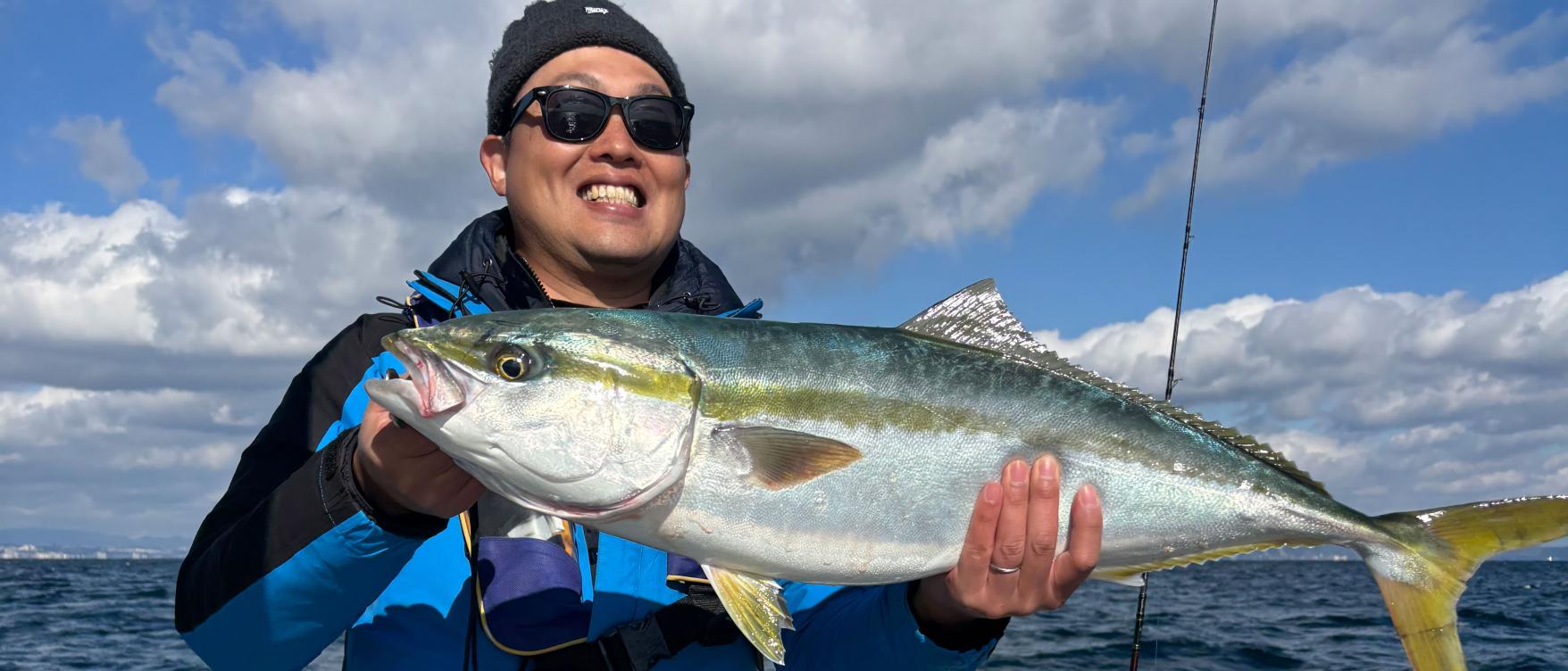
Enjoy a great fishing experience in Kagoshima's Kinko Bay!
-

Re-Wild Kagoshima: The ultimate healing experience of interacting with the “Happy Horses”
-
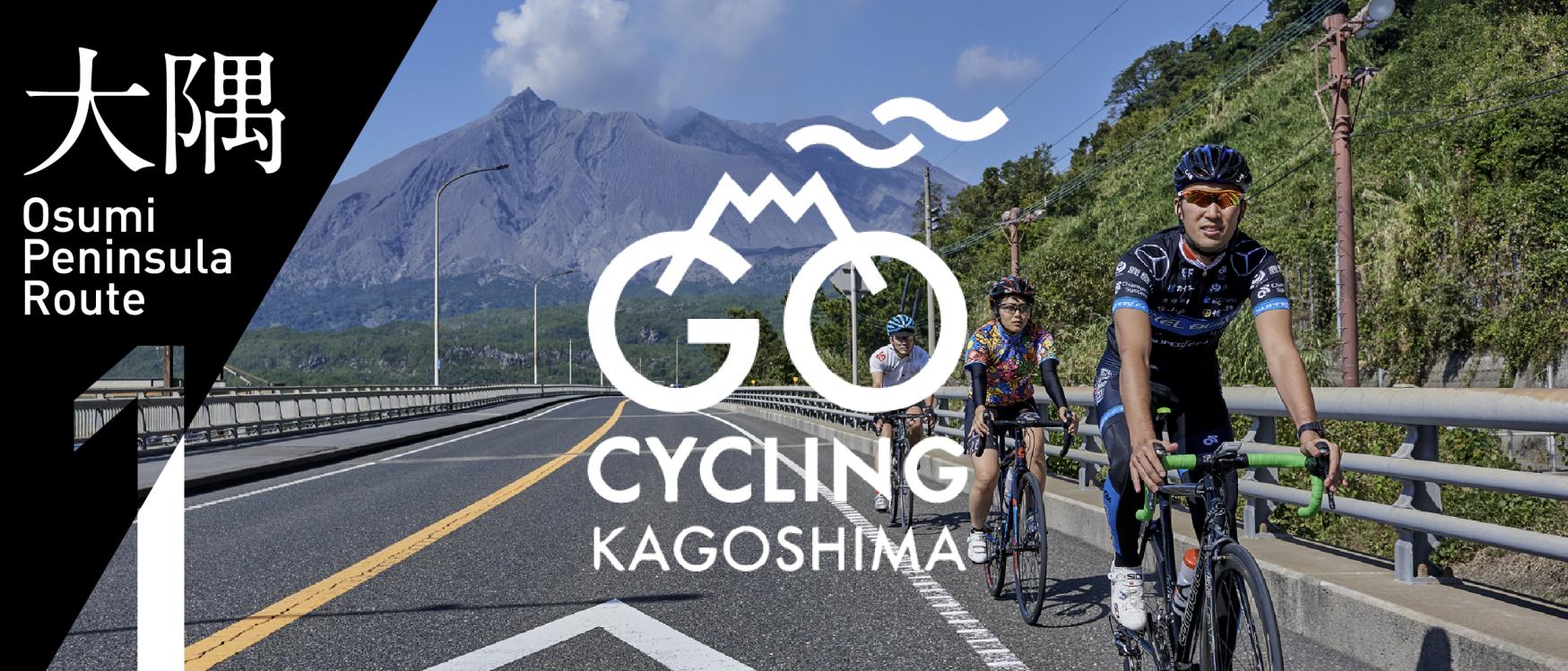
Now is the time for a bike trip! Cycle beautiful Kagoshima
-
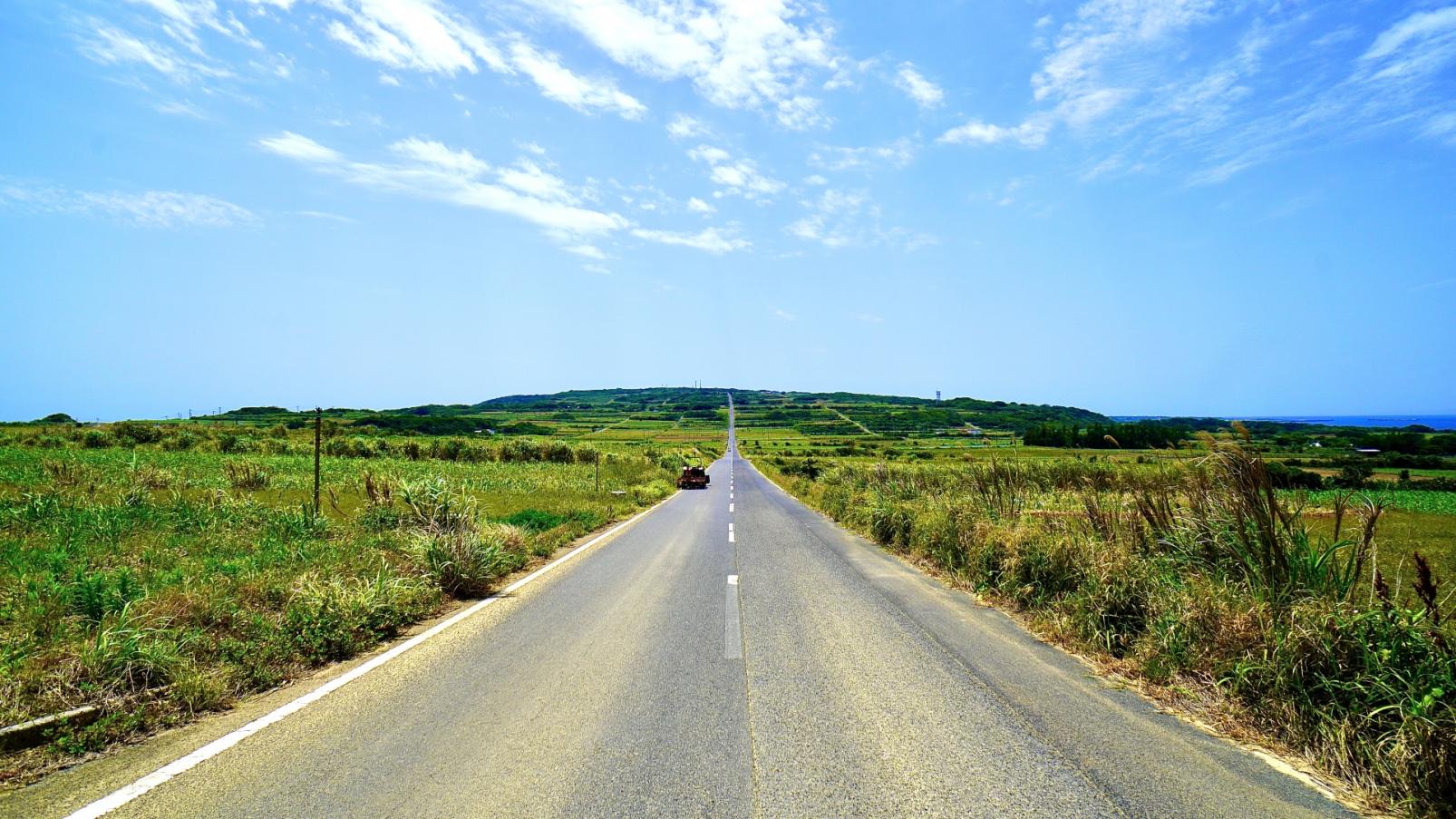
Kikaijima Course, an island where mysterious giant banyan trees and butterflies dance



